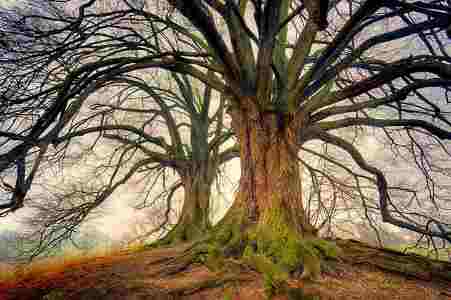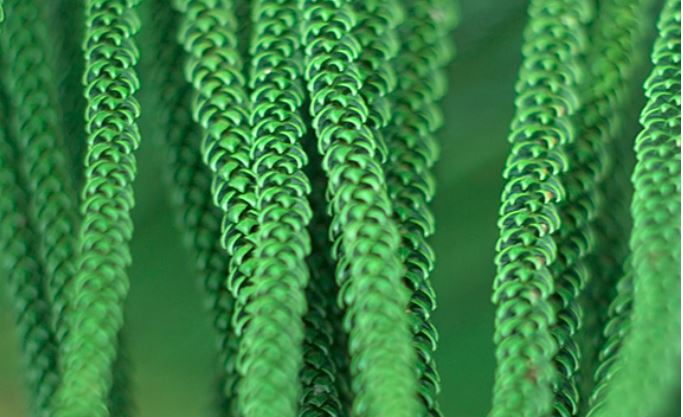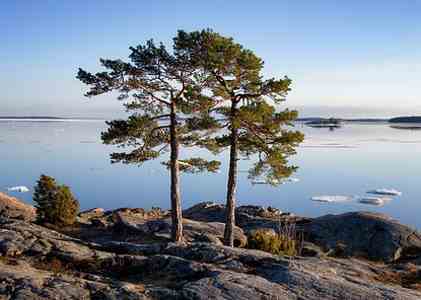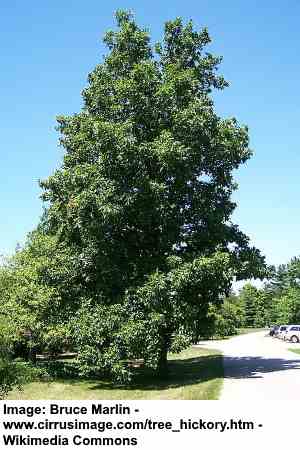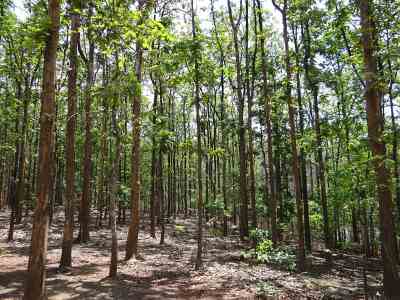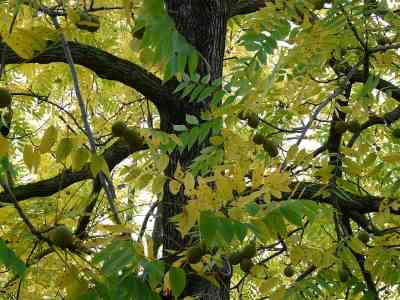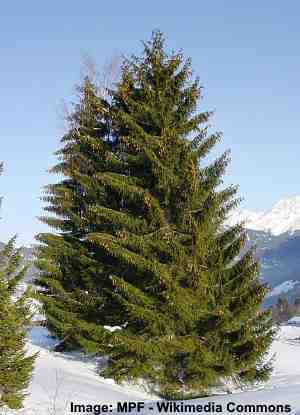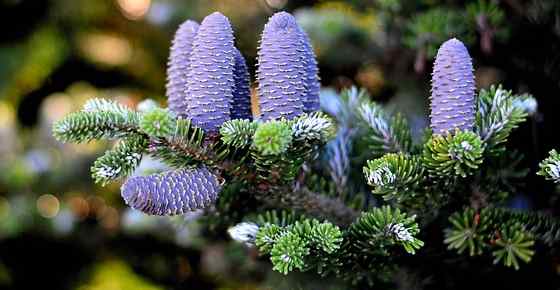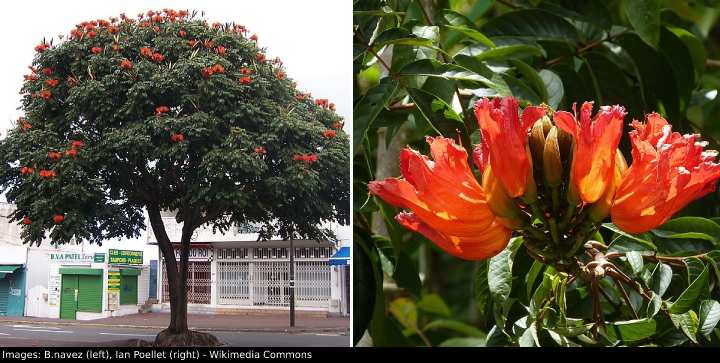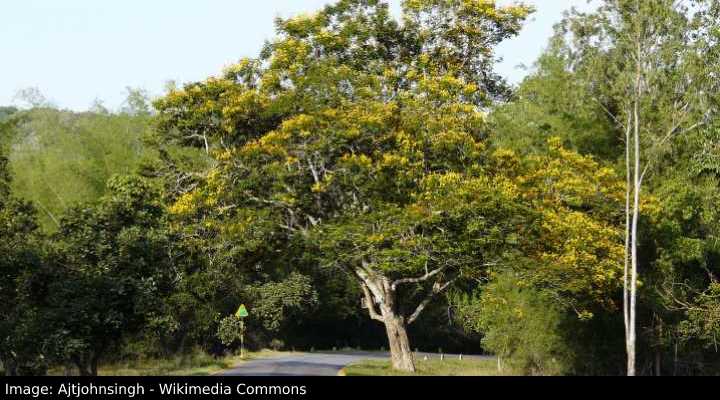121 Types of Trees with Their Name and Picture – Identification Guide
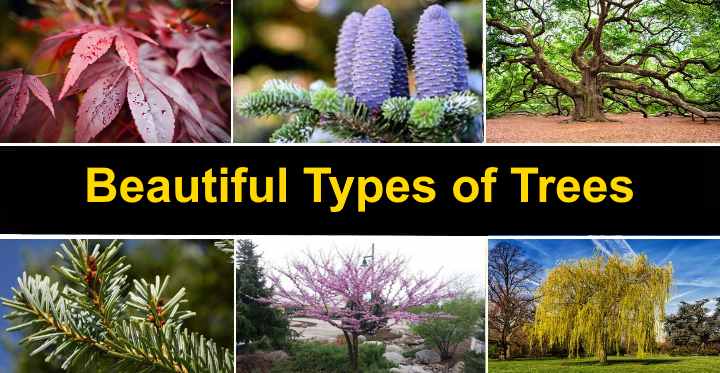
All types of trees play an important role in our ecosystem. Trees provide shade, shelter, oxygen, and many even produce fruit. There are over 60,000 species of trees that come in all shapes and sizes, from majestic cedars to smaller fruit trees and shrubs. Identifying the different kinds of trees usually depends on examining their leaves and bark. Some types of trees have wide oval leaves, some have star-shaped ones, and many evergreen trees have needle leaves.
All species of trees are classified into two main types: deciduous trees and evergreen trees. Deciduous trees shed their leaves at a certain time of the year – usually in the autumn while types of evergreen trees keep their leaves throughout the year.
Trees are woody perennial plants that are a member of the kingdom Plantae. All species of trees are grouped by their genus, family, and order. This helps make identifying and studying trees easier.
Apart from providing oxygen for the planet and beauty when they bloom or turn color, trees are very useful. Certain species of hardwood and softwood trees are excellent for timber, making furniture, and paper. When managed properly, trees are a good source of renewable energy and construction material.
In this article, you will learn how to identify many different types of trees. Most of these trees are common in North America, Europe, and other countries around the world.
Two Main Categories of Trees
All of the thousands of species of trees fall into two categories – deciduous trees and evergreen trees.
Deciduous trees
Deciduous trees are the kind of trees that lose their leaves at certain times of the year. The term deciduous literally means to “fall off at maturity.”
In North America, Europe, and temperate counties, deciduous trees such as oak, walnut, elm, and birch shed their leaves in fall. This is usually preceded by the leaves turning wonderful colors including shades of orange, brown, and yellow.
In tropical countries, species of deciduous trees lose their leaves during dry seasons.
Evergreen trees
Species of evergreen trees such as spruce, pine, and fir trees keep their leaves throughout the year. There are about 14 family groups of evergreen trees, and these trees provide color in gardens and landscapes all year long. Evergreen trees are the reason why forests look so beautiful in winter landscapes.
Identifying the Types of Tree Leaves
Tree identification is usually possible by examining the leaves.
There are three basic leaf types: broadleaf, needles, and scales.
Broadleaf
Most, but not all, deciduous plants have broadleaves that can be in all shapes and sizes. The leaf shapes can be oval, rounded, long and narrow, triangular, or heart-shaped. Some easily identifiable broadleaves are the iconic maple leaf and the oak leaf with its lobed leaves.
Needle leaves
Many evergreen trees such as conifers, pines, and spruce trees have needle leaves. These can be long, thin and straight and grow in clusters. Or, the needles could be soft needles that grow sparsely on the twig.
Scale leaves
Some types of evergreen trees like juniper and cedar have scale-like leaves. Their leaves look more like scales than needles.
Other ways to identify trees by their leaves include:
- Opposite leaves grow directly across from each other on the leaf stem.
- Alternate leaves grow in a staggered, alternating pattern along the stem.
Types of Trees With Pictures and Identifying Features
Here is a list of many types of common trees that grow in forests, woodlands, fields, and gardens.
Birch Trees
There are approximately 60 species of hardwood birch trees within the genus Betula and the Betulaceae family. Birch trees are easily recognizable due to their white or silver-colored bark, and their long drooping branches bear small, thin leaves. Birch wood is hard and well-suited for crafting furniture and plywood, making it a valuable resource for both firewood and practical applications.
Tree identification: Birch trees have small triangular-shaped leaves with slightly serrated edges. Another recognizable feature is that the bark of birch trees is papery. Depending on the species of birch, the smooth bark can be dark gray to white.
Maple Trees
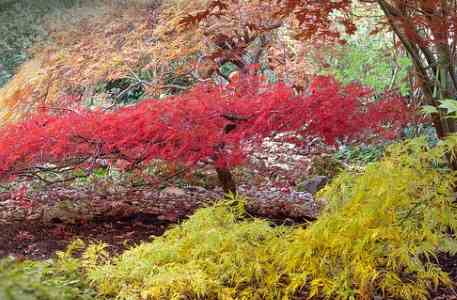
Japanese maple (botanical name: Acer palmatum) is a small deciduous tree with many cultivars growing worldwide
Maple trees are beautiful deciduous shade trees with deeply lobed leaves. Maple trees have dark brown furrowed bark, small winged fruits, and narrow reddish-brown twigs.
Maple trees belong to the genus Acer in the family Sapindaceae. Although the maple tree is commonly associated with Canada, most of the species are native to Asia. The most common maple tree species in Europe is the sycamore maple tree (Acer pseudoplatanus), and there are 10 species native to Canada.
Some of the most popular maple trees are the sugar maple (Acer saccharum), ‘Autumn Blaze’ maple (Acer x freemanii ‘Autumn Blaze’), red maple (Acer rubrum), and Japanese maple (Acer palmatum).
The most famous product made from maple trees is the sweet maple syrup made from the tree’s sap. Although you can make syrup from any maple tree, it’s only the sugar maple tree (Acer saccharum) that produces quality sweet syrup.
Maple is a hardwood tree that is also useful for making baseball bats and its timber is valued in the construction industry.
Tree identification: Maples can be woody shrubs growing about 33 ft. (10 m) tall or large majestic trees up to 150 ft. (45 m) tall. The most common identifying feature of maple trees is their lobed leaves growing opposite each other on branches.
Ash Trees
Ash trees (Fraxinus) are medium to large deciduous trees with a rounded crown of dark green leaves. Ash trees have lanceolate pinnate leaves that grow in groups of five, seven, or nine leaflets. Most species of mature ash trees have gray bark with a pattern that looks like a fishnet.
Most varieties of ash trees grow to between 50 and 80 ft. (15 – 24 m) tall. The medium-sized trees have a spreading round canopy up to 50 ft. (15 m) wide. Most varieties of ash trees grow in USDA zones 3 to 9 in full sun.
Ash is a species of tree native to North America and it’s a common tree in parks, deciduous forests, woodlands, and residential neighborhoods.
Ash trees are a species of hardwood tree in the genus Fraxinus and family Oleaceae. This means that ash trees are related to olive trees and woody lilac bushes.
Ash tree wood is prized for its strength and flexibility. The grain in the wood is also attractive and this makes the tree valuable for furniture makers.
Tree identification: Ash trees have large, pinnately compound leaves. Ash tree leaves have a narrow and slightly oval shape and they usually have five or seven leaflets. Mature ash trees have bark with ridges that form diamond shapes. Ash tree branches grow oppositely from each other.
Further reading: Ash Tree: Types, Bark and Leaves – Identification Guide.
Oak Trees
Oak trees are hardwood trees that are common in North America and Europe. There are over 90 oak species in the United States. Oaks can be trees or shrubs and are in the genus Quercus and the family Fagaceae.
Oak trees are well-known for producing wood that is extremely hard, durable, and resistant to disease. Oak wood has been prized for centuries and was used to make ships, create interior paneling, and also barrels for storing wines and spirits.
Oak trees are divided into two groups: white oaks (Quercus, subgenus leucobalanus) and red oaks (Quercus, subgenus Erythrobalanus). White oak trees have gray-colored bark and leaves with rounded lobes. Red oak trees have darker-colored bark and leaves with pointed lobes.
Oak trees are known for their acorns (also called oak nuts). Acorns have a smooth leathery shell that sits in a cup called a cupule. The acorns of white oak trees have a sweet or slightly bitter taste, however the acorns from red oak trees have a very bitter taste.
Tree identification: Most species of oak are deciduous trees and a few are evergreen (such as the live oak tree). Oak trees can be identified by their lobed leaves with pointed or rounded tips. Oak trees also produce acorns which are oval-shaped nuts sitting in a small cup-like structure called a cupule.
Related: Types of Oak Trees and How to Identify them (Pictures)
Sycamore Trees (Platanus)
Sycamore trees are large deciduous trees with a broad, rounded crown of lush green foliage. Sycamore trees have large serrated lobed leaves that look like maple leaves. These huge trees have thin, peeling reddish-brown bark. Sycamore trees can grow to huge proportions with some reaching heights of 130 ft. (40 m).
In the late autumn or winter, sycamore trees have round brown seed balls hanging on their branches.
Sycamore is a species of large hardwood tree in the genus Platanus. Sycamore wood is very hard and dense and not easy to work with.
Sycamore trees are fast-growing popular shade trees in city landscapes and parks. However, their roots have a destructive effect on sidewalks and building foundations. They are one of the largest deciduous trees native to North America.
The most common sycamore tree species in North America is the Platanus occidentalis which is also called the American sycamore. Other common names for the American sycamore tree are buttonwood tree, western plane tree, American plane tree, and water beech.
London Plane Tree (Platanus x acerifolia)

London Plane tree (Platanus × acerifolia)
Another type of sycamore tree is the London plane tree (Platanus x acerifolia). This is a hybrid deciduous tree of the American sycamore (Platanus occidentalis) and Oriental plane tree (Platanus orientalis) species. London plane tree grows between 66 and 100 ft. (20 – 30 m) with a large, rounded crown up to 75 ft. (22 m) wide. The hybrid tree grows well in urban environments. It is found in major cities across the United States as a popular street tree.
Tree identification: Sycamores trees often have bark that easily flakes off, giving the trunk a reddish-brown, multicolored look. Sycamore trees have large lobed leaves that look similar to maple leaves. The leaves grow alternately on stems and have 3 to 5 lobes with toothed edges.
Cedar Trees (Cedrus)
Cedar trees are large evergreen coniferous trees that have needle-like leaves that are arranged spirally on scented woody branches. Cedar trees are native to the Mediterranean region. True cedar trees are in the plant family Pinaceae and the genus Cedrus.
Cedar trees are a type of hardwood and can grow especially tall with some of the largest species growing up to 164 ft. (50 m) high. Because of their grace and elegance, cedars are popular ornamental trees and are often cultivated as bonsai trees. Cedar trees are also popular for their aromatic wood and fragrant foliage.
There are hardwood trees native to North America that have “cedar” in their common name. But these types of cedars are in the list of false cedar trees. If you check their scientific name, many are species of junipers in the family Juniperus.
Tree identification: Cedar trees have scale leaves that grow in dark green or bluish-green spiral clusters. There could be between 15 and 45 clusters on short shoots that make up the leaves on branches.
Juniper Trees (Juniperus)
Juniper trees are often called cedars but they belong to a different genus and family. Junipers (genus Juniperus in the family Cupressaceae) are evergreen conifers trees and shrubs with needle-like or soft scaly leaves that have a pine scent and dark-blue berry-like aromatic fleshy cones.
Species of juniper trees are tall columnar evergreens that grow between 66 and 103 ft. (20 – 40 m) tall. However, junipers can also grow as low-growing, spreading shrubs growing as little as 1 ft. (0.3 m) or as tall as 5 or 6 ft. (1.5 – 1.8 m). Junipers also grow in many climates and can withstand freezing temperatures.
Some popular types of junipers in North America include the Common juniper (Juniperus communis), California juniper (Juniperus californica), the eastern red cedar (Juniperus virginiana) and Utah juniper (Juniperus osteosperma).
Tree identification: Most species of juniper have needle-like leaves when they are immature that grow into scale leaves as the tree ages, with dark blue berry-like cones.
Further reading: Juniper Trees and Shrubs: Types, Leaves, Berries – Identification Guide.
Willow Trees

Willows are deciduous flowering trees and shrubs that prefer very moist soil
Willow trees are easily identified by their long drooping branches covered in oval elongated leaves. The leafy woody plants in the willow family are deciduous and can be low-growing shrubs or medium-sized trees.
There are about 400 species of willow that belong to the genus Salix. Willows can be large weeping trees, dwarf trees, or low-growing creeping shrubby plants.
One of the interesting features of willow tree leaves is their color. Willow leaves can be greenish-yellow, bluish-green or have red blushing.
Wood from willow trees tends to be soft and flexible and the branches are often used for making wicker baskets.
Tree identification: Willow leaves are simple and elongated with serrated edges. Willows are usually last to drop their leaves in fall.
Pine Trees
Pine trees are often used as ornamental trees and are a softwood type of conifer. Evergreen trees in the genus Pinus are probably the most recognizable type of coniferous tree.
Pine trees produce hard cones and their leaves are clusters of needle leaves. Pine trees grow tall and straight with some of the largest species reaching heights of 268 ft. (81 m). Because of their fast growth, pine wood is important in the construction and furniture industries.
Most types of pine trees have reddish-brown or gray bark and there is also a species called the Red pine.
Tree identification: Their tall straight trunks and needle like leaves that grow near the top of the tree make these evergreens easy to identify.
Hickory Trees
Hickory trees are deciduous trees in the genus Carya that are common in North America, China, and India. Hickory trees are well-known for their edible nuts.
There are 18 species of hickory trees, 12 of which are native to North America. The most common types of hickory trees are shagbark hickory (Carya ovata) and shellbark hickory (also called kingnut or Carya laciniosa).
Pecan trees are also a type of hickory tree as they are in the Carya genus and their botanical name is Carya illinoinensis. Pecan tree bark is interesting because the bark splits and peels as the tree grows.
Hickory trees are related to walnut trees because they are in the walnut family (Juglandaceae). Hickory is a type of hardwood that is used for making sports equipment such as bats and sticks, as well as being used for smoking cured meats.
Tree identification: Hickory trees can be identified by their large green leaves that have a pointed tip at the end and they grow alternately on the stems. Hickory produces edible nuts that are in a “double” shell.
Redbud Trees
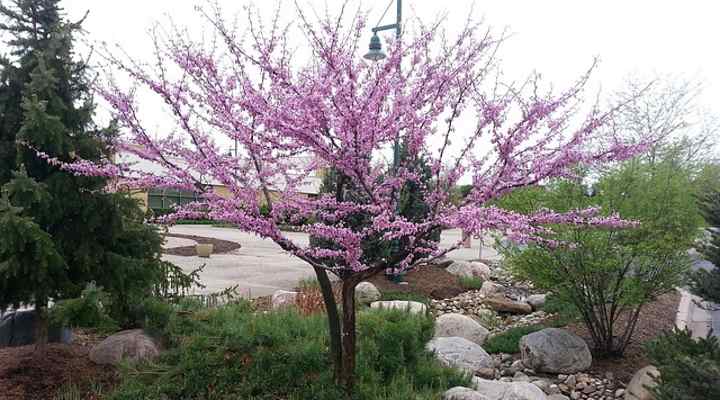
Blooming Redbud tree
Redbud trees are small flowering trees that are famous for their beautiful pink or white spring flowers. Redbud trees have heart shaped leaves and their seedpods have a dark brown color. Redbuds are deciduous trees that have green leaves in the summer that then become yellow, orange or red during autumn. Redbud trees belong to the plant family Fabaceae and the genus Cercis.
One of the most common redbud trees is the Eastern Redbud (Cercis canadensis). The Eastern redbud tree is named for where it commonly grows, which is in eastern North America.
Some of the names of redbud tree varieties are Ruby Falls redbud, Forest Pansy redbud, and Ace of Hearts redbud.
Tree Identification: Redbud trees can be identified by their pink flowers and heart-shaped leaves. Many cultivars of the redbud species Cercis canadensis have different flower colors and tree sizes. Redbud trees can have light pink, white, or dark pink flowers.
Mahogany Trees
Mahogany trees stand tall and impressive in nature. Their dark, shiny leaves create a beautiful crown, while the bark starts smooth and turns wrinkled as the tree gets older. When they bloom, small fragrant flowers appear on the branches. Over time, the wood changes from warm reddish-brown to a deeper shade.
Mahogany is a type of redwood tree renowned for its robustness and straight grains. True mahogany trees belong to the genus Swietenia, comprising three species native to North and South America. Varieties of mahogany trees within the Meliaceae family thrive in Asia, Africa, and New Zealand.
Mahogany wood is prized for its enduring reddish-brown hue and exceptional durability. Resistant to rot and boasting tonal properties, mahogany is an excellent choice for crafting musical instruments.
Tree identification: Mahogany tree is distinguished by its rich brown-red wood, which deepens over time. Mahogany tree leaves are oval-shaped and grow in pairs along the stem.
Teak Trees
Teak are massive deciduous trees that belong to the genus Tectona. Some species of teak tree can grow up to 131 ft. (40 m) tall and their branches produce thin, papery leaves.
Teak is a type of hardwood that is popular with furniture makers and boat builders. The reason why teak wood is widely used is that it is very weather resistant. Often, outdoor furniture, window frames, flooring, and boat decks are constructed from teak trees.
Tree identification: Teak tree leaves are large and ovate with smooth surfaces and edges.
Walnut Trees
Walnut trees generally have rough bark with deep fissures. The ridges in their bark run vertically up and down the trunk. The color of the walnut bark can be light gray to dark brown.
Walnut trees are best well-known for their delicious and healthy edible nuts. Walnuts are deciduous trees in the genus Juglans and the family Juglandaceae. Walnut trees also tend to be large, massive trees that grow to between 33 and 131 ft. (10 – 40 m) tall. They also have a large spread.
The most important species of walnut tree for nut production is the Juglans regia, or black walnut. This species of walnut is an important source of hardwood timber.
Tree identification: Walnut tree leaves are alternate and are comprised of leaflets that grow opposite each other.
Further reading: Walnut Trees: Types, Bark and Leaves – Identification Guide.
Apple Trees
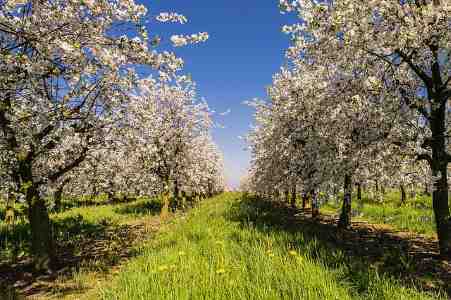
Apple tree is a very popular and common type of fruit tree that is cultivated worldwide and has a beautiful blossom
Apple trees are a genus of large trees in the family Rosaceae that produce beautiful flowers and a crop of apples.
Apple trees grow in most countries in the world and the most common species is the Malus domestica tree. It is reckoned that apple trees are the oldest cultivated tree in history. It is estimated that there are over 7,500 different kinds of apple trees.
Apple trees can grow to 40 ft. (12 m) tall and have a spread of the same size. There are plenty of dwarf apple tree cultivars for gardens that may just grow 3 – 6 ft. (1 – 2 m) high.
Tree identification: Apple tree leaves are alternate, pointy, and egg-shaped.
Crabapple Trees
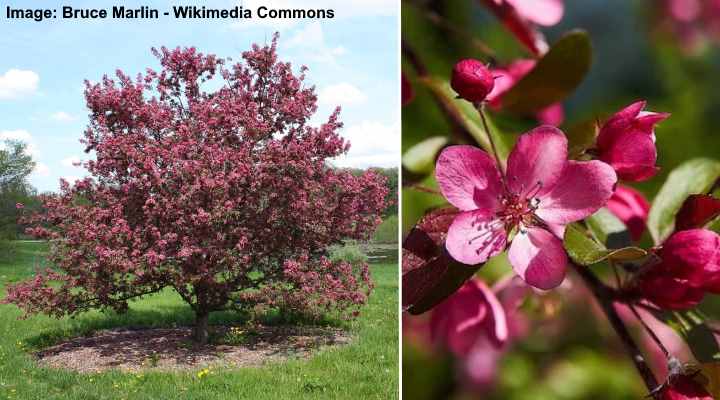
Crabapple Purple Prince (Malus ‘Purple Prince’)
Crabapple trees (botanical name Malus) are like miniature apple trees (Malus domestica). The smallest crabapple trees can be small shrub-like bushes around 4 ft. (1.2 m) tall. Larger crabapples can grow to between 20 and 30 ft. (6 – 9 m).
Crabapple trees are stunning ornamental flowering trees. Crabapple flowers come in spectacular shades of pink, white, purple, orange, and red. Additionally, crabapple trees produce small tart fruits called crabapples.
Crabapple fruits are generally up to 2” (5 cm) in diameter and can be yellow, amber, orange, red or purple. The taste of crabapples ranges from sweet to very sour and bitter. They are made into jellies, sauces, pickled crabapples, and jams.
Further reading: Crabapple Trees (Malus): Types, Flowers, Fruits.
Ornamental Flowering Pear Trees
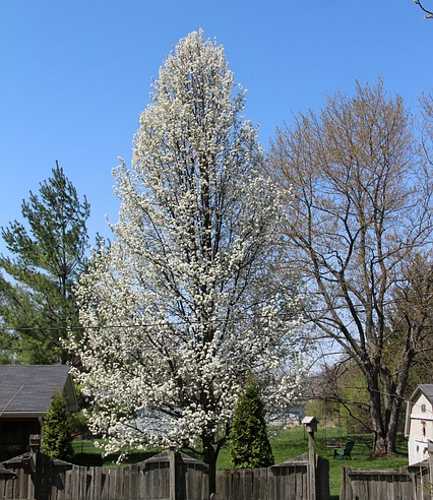
Ornamental pear trees flower with beautiful white flowers every spring. In the picture: Bradford ornamental pear tree in bloom
Ornamental pear trees (Pyrus calleryanaare) are deciduous flowering trees with shiny green leaves, cup-shaped white flowers, and beautiful fall colors. Most varieties of Pyrus calleryana have a pyramidal, upward growth shape. Ornamental pear trees grow between 32 and 40 ft. (10 – 12 m) tall and around 22 to 30 ft. (7 – 9 m) wide.
Although all flowering pear trees—including Pyrus calleryana—actually produce fruit, the tiny pears on ornamental pear trees are too insignificant to be useful. The pears are exceedingly small, measuring only about half an inch (1 cm). Pyrus calleryana fruit also tastes bitter, and, for most people, the small pears are inedible.
Ornamental pear varieties are heat and drought-tolerant and are resistant to many fruit tree diseases. These facts make ornamental pear trees popular for front and backyards. Ornamental flowering pear trees grow in USDA zones 5 through 9.
Further reading: Types of Ornamental Flowering Pear Trees – Fruitless Pear Trees.
Cherry Trees
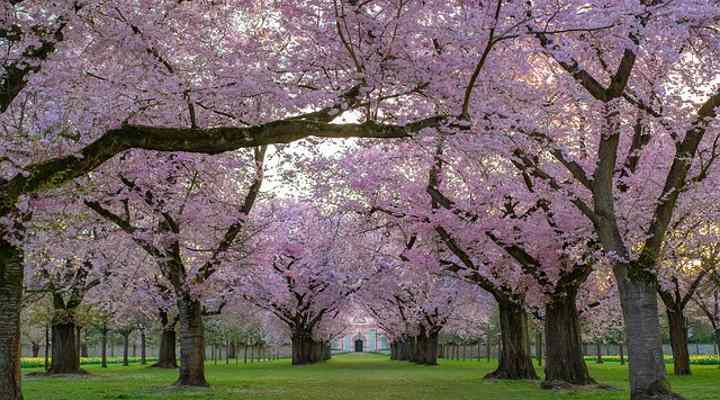
Cherry trees have many cultivars that include edible fruit trees, ornamental flowering trees, weeping and dwarf trees
Cherry trees (Prunus) are spectacular deciduous flowering trees that bloom in spring. There are hundreds of varieties of cherry trees that can be identified by their fruit or blossoms.
There are sweet cherries (Prunus avium), sour cherries (Prunus cerasus), and ornamental cherry blossom trees, such as the Japanese cherry blossom tree (Prunus serrulata) and Yoshino cherry (Prunus x yedoensis). Typically, fruit from cherry blossom trees is too small and sour to eat—although they are a favorite of many birds.
For smaller gardens or limited spaces, consider opting for dwarf cherry blossom trees. These charming trees typically flourish in USDA zones 5 through 8, thriving in full sun and well-drained, fertile soil.
Additionally, there are weeping cherry trees, such as the weeping Higan cherry (Prunus subhirtella ‘Pendula’), along with dwarf weeping cherry varieties that attain heights of 3 to 6 ft. (1 – 2 m).
Cherry trees have beautiful whitish-pink blossoms in spring between mid-March and mid-April covering bare branches. Cherry trees have glossy green oval leaves with pointed tips and serrated edges.
Cherry trees grow in USDA zones 5 through 9. However, some cold-hardy cherry trees can withstand temperatures in zone 4.
Further reading: Types of Cherry Trees with Their Leaves and Flowers – Identification Guide.
Hawthorn Trees
The botanical name for hawthorn trees is Crataegus and they are in the same family (Rosaceae) as apples. Hawthorns are a type of tree or shrub that is native to Europe, Asia, and North America. Leaves from the hawthorn tree grow spirally on long shoots.
Because of their attractiveness, hawthorns are grown as street trees or ornamental trees and the smaller shrubs also make great hedges.
Other names for hawthorns include ‘thornapples,’ ‘hawberries,’ ‘mayhaw,’ or ‘May-tree.’
Tree identification: Hawthorn leaves come in many different shapes. Some types of hawthorn trees have leaves that are deeply lobed and look like large parsley leaves. Other hawthorn leaves look more ovate due to having shallow lobes.
Elm Trees
Elm trees are a common type of forest tree that are classed as deciduous or semi-deciduous. There are about 35 species of elm in the genus Ulmus. Some common species of elm include American elm (Ulmus americana), European elm (Ulmus glabra), and Slippery elm (Ulmus rubra).
Elm trees are large shade trees that can grow up to 100 ft. (30 m) tall with a wide spread of around 75 ft. (22 m). Some elm species have tall, upright growth, and other types of elm trees have an umbrella-shaped canopy.
Tree identification: Elm is a thick, dense hardwood tree and some species are especially ornamental and beautiful. Elm leaves are classed as broad-leaves that can be between 7 and 16 cm long and their ovate shape tapers to a point. Elm bark is a dark grayish-brown color with deep furrows and a scaly appearance. Elm tree seeds are small and round and are protected in an oval papery casing called a samara.
Read more: Types of Elm Trees with Their Bark and Leaves – Identification Guide.
Spruce Trees
Spruce trees make up many of the types of forests in North America and are a type of coniferous evergreen tree. Spruces are classed as large trees that belong to the Picea genus. One feature of spruce trees is that they are extremely cold hardy. Some of the larger spruce species are very imposing because they can be as high as 200 ft. (60 m).
All of the 35 species of spruce trees have pine needles that radiate equally around the stems and can be prickly. The most common spruce trees in North America are the Red spruce, Black spruce, and White spruce. Spruce trees are also traditionally used as Christmas trees. Spruce trees are also one of the most important trees for the timber industry.
Tree identification: Spruce tree cones are long and cylindrical that hang down off the tree. Also, the leaves of spruce trees are rows of green, bluish-green, or silver-green needles.
Fir Trees
Fir trees are large evergreen conifer trees that are mainly found in forests in North America, Europe, and Asia. They have needle-like leaves that stay green all year long. Some species of fir trees such as the Fraser fir, balsam fir, and noble fir are popular types of Christmas trees.
The easiest way to identify fir trees is by looking at their needles and cones. The needles of fir trees tend to be softer than pine or spruce. Unlike the clusters of pine needles on a branch, fir tree needles attach individually to the branches and not in clusters. Also, fir cones tend to grow upward from the branches.
The bark of young fir trees is usually smooth and gray. As the tree matures the bark becomes ridged.
Read more: Types of Fir Trees – Identification.
Hemlock Trees
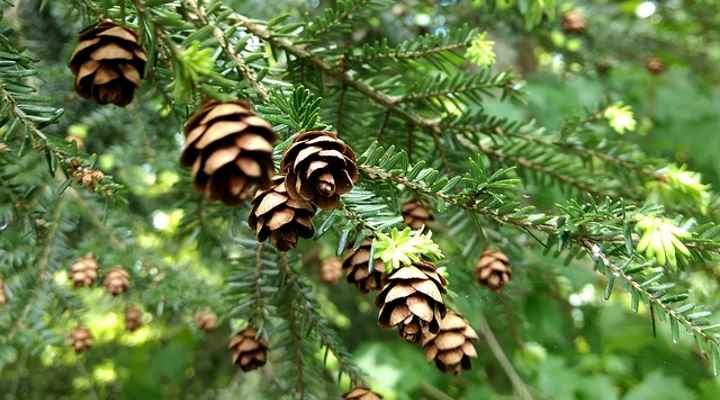
Cones and foliage of Canadian hemlock (Tsuga canadensis)
Hemlock trees (botanical name Tsuga) are a species of large evergreen coniferous trees native to North America that belong to the pine family.
Native hemlock trees generally grow between 30 and 230 ft. (10 – 70 m) tall. However there are dwarf cultivars of the popular Eastern hemlock or Canadian hemlock that are beautiful landscaping trees to suit small gardens.
Hemlock trees are identified by their conical shape, flat, aromatic needle-like leaves, oval or cylindrical seed-bearing cones, and reddish-brown bark. Hemlock needles are recognizable by their flat appearance and blunt, rounded tips, with a smooth, shiny dark green upper side and parallel white stripes on the underside.
Hemlocks are cold-hardy evergreens that grow in USDA zones 3 to 7. They perform well in damp soils and can be found growing in wetlands.
Further reading: Hemlock Trees (Tsuga): Canadian, Western, Leaves, Bark – Identification.
Locust Trees
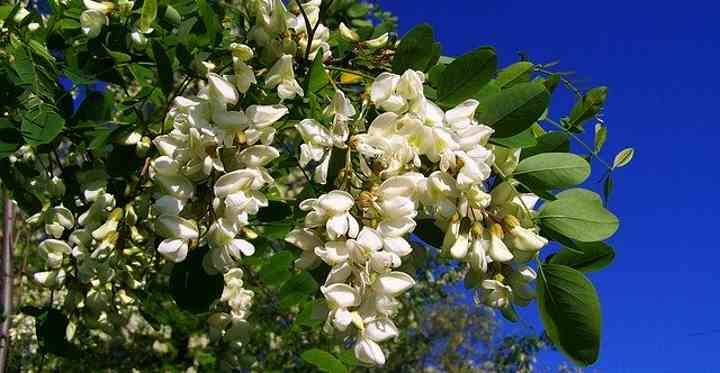
Flowers of the black locust tree
Locust trees are fast-growing flowering trees that grow to between 66 and 98 ft. (20 – 30 m) and belong to a family of flowering plants called Fabaceae. Most types of locust trees grow in the eastern states of North America.
The most common types of locust trees are the black locust and honey locust trees. Locust trees have fragrant sweet spring flowers and colorful fall foliage. Many varieties of locust trees have long sharp thorns and there are a few thornless species.
Locust trees are hardy trees that are known for their hard and durable wood that is used for making furniture, fence posts, flooring, and small boats.
Identifying species of locust trees can be done by features such as their flowers, color of bark, height of the tree, the thorns, as well as by the shape and color of its seed pods.
Read more: Types of Locust Trees with Identification Guide and Pictures.
Cottonwood Trees
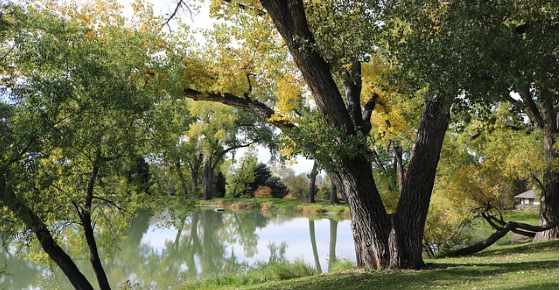
Cottonwood trees are species of poplar trees belonging to the genus Populus
Cottonwood trees are huge deciduous forest trees that have large green leaves, thick foliage and deeply fissured grayish-brown bark. One of the common features of all types of cottonwood trees is their fluffy cotton-like strands that appear in early summer. These large trees can grow to between 50 and 80 ft. (15 – 24 m) and some species can grow even higher.
Cottonwood trees are common in North America, Europe, and some parts of Asia. Cottonwood trees are popular because they are fast-growing, their timber is cheap, and they thrive in wetlands and arid environments.
For many people, the fluff from cottonwood trees is a nuisance and can trigger allergic reactions. However, it’s important to note that only the female species of cottonwood trees produce the characteristic white fluff.
Read more: Cottonwood Trees: Facts, Identification, Pictures and More.
Poplar Trees (Populus)
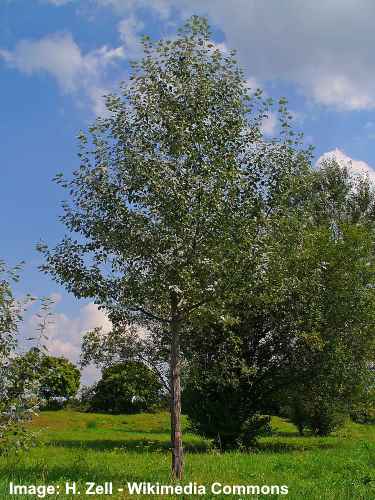
White poplar tree (Populus alba)
Poplar (Populus) trees are large deciduous trees with rounded to triangular leaves, attractive grayish bark, and small clusters of drooping flowers.
Many poplar trees are identified by their bark’s color— white, gray, or black— and triangular, ovate leaves. The white poplar, the most common poplar tree, features white bark, as well as leaves that are white and green that create a ‘twinkling’ effect in gentle breezes.
Apart from the common white poplar tree (Populus alba), other types of poplars include the black poplar (Populus nigra) and balsam poplar (Populus balsamifera).
Many poplar species are large ornamental trees with wide canopies, making for excellent shade trees. Native poplar trees are easy to grow and have a relatively short lifespan. These fast-growing trees are good choices for planting in wet, moist ground where there is plenty of space.
Poplar trees range in height and grow in USDA zones 3 through 9.
Further reading: Poplar Trees: Types, Bark, Leaves – Identification.
Arborvitae Trees (Thuja Trees)
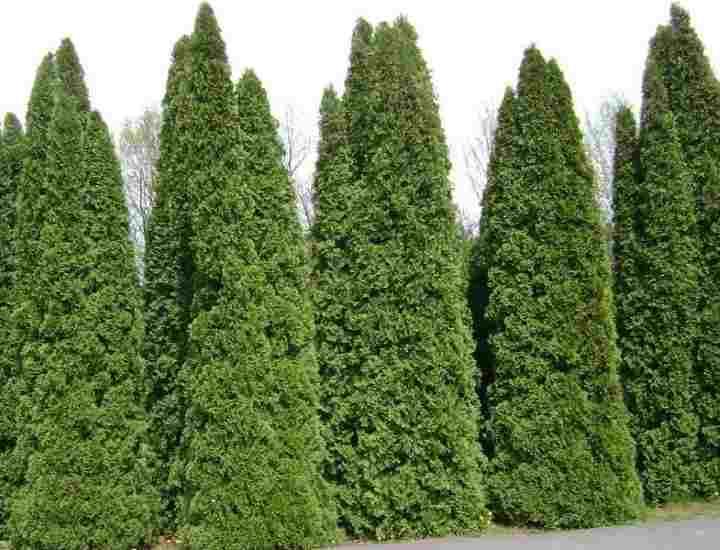
American arborvitae (Thuja Occidentalis) makes great privacy tree or hedge
Arborvitaes (Thuja) are evergreen conifers with soft, lush feathery foliage. Different types of arborvitaes grow as upright columnar trees, small conical trees, or globe-shaped shrubs. Arborvitae trees and shrubs are ideal for natural privacy screens, wide hedges, living fences, or specimen trees.
The American arborvitae (Thuja occidentalis) and Giant arborvitae (Thuja plicata) are native to North America and are popular choices for garden landscaping. American and giant arborvitaes can reach heights of up to 49 ft. (15 m), but smaller cultivars have been developed to accommodate limited spaces.
The ‘Emerald Green’ arborvitae is one of the most popular landscaping trees in the Thuja species. Also called ‘Smaragd,’ this upright columnar arborvitae has a compact growth habit, reaching up to 14 ft. (4 m) in height.
Read more: Varieties of Arborvitae Hedges, Trees, and Shrubs.
Cypress Trees (Cupressus)
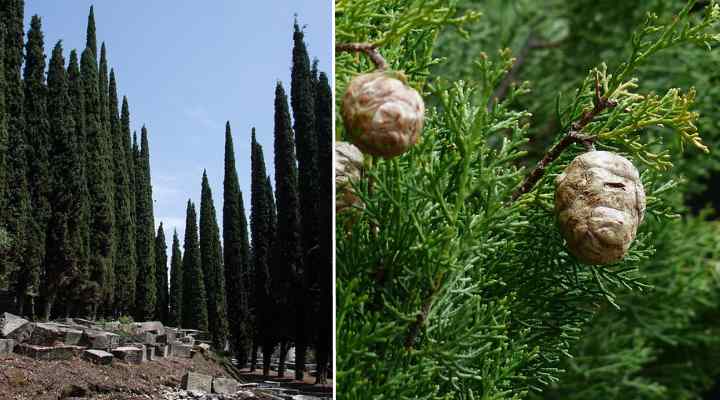
Mediterranean Cypress / Italian Cypress (Cupressus sempervirens) trees, foliage and cones
There are various trees bearing the common name ‘cypress’; however, not all of them belong to the true cypress group. True cypress trees are part of the coniferous plant genus Cupressus.
Cypress trees are characterized by their soft, feathery evergreen foliage and the production of cone-like structures resembling large acorns. Examples of true cypress trees include the Monterey cypress (Cupressus macrocarpa) and the Mediterranean Cypress, also known as Italian Cypress (Cupressus sempervirens).
On the other hand, false cypress trees are evergreen and deciduous coniferous trees that share the cypress name, but they do not belong to the Cupressus genus. Notable examples of false cypresses include the bald cypress (Taxodium distichum) and the Pond Cypress (Taxodium ascendens). Additional false cypress varieties encompass the Hinoki cypress (Chamaecyparis obtusa) and the Lawson Cypress (Chamaecyparis lawsoniana)
Read more: True and False Types of Cypress Trees.
Eucalyptus Trees
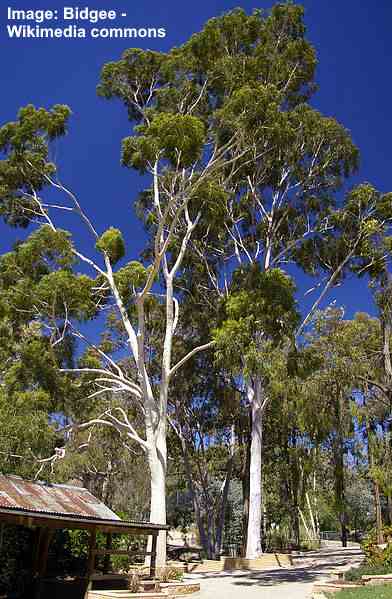
Lemon eucalyptus trees (Eucalyptus citriodora / Corymbia citriodora)
Eucalyptus trees have evergreen aromatic leaves and attractive smooth peeling bark. The unusual eucalyptus flowers have a fuzzy look and can be white, cream, yellow, pink, or bright red colors.
Eucalyptus plants are flowering trees and shrubs with over 700 species. Some species of eucalyptus trees can grow as tall as 330 ft. (100 m). Eucalyptus shrubs—known as mallees—grow up to 33 ft. (10 m) tall.
Some types of Eucalyptus trees are called gum trees, and fruit from eucalyptus plants are called gumnuts. Eucalyptus plants are native to Australia but also grow in tropical and temperate climates throughout the world.
Further reading: Types of Eucalyptus Trees: Leaves, Flowers, Bark.
Dogwood Trees (Cornus)
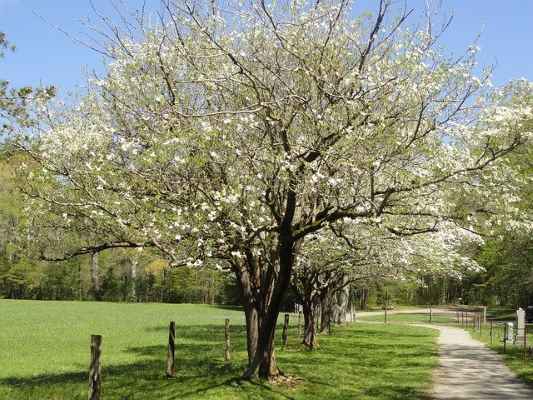
Flowering dogwoods are small to medium size trees that add a decorative touch to any garden
Dogwoods are beautiful flowering deciduous trees belonging to the genus Cornus with distinctive flowers, berries, bark, and leaves. Dogwood flowers bloom in spring and are typically white, but some species produce yellow, pale red or pink blossoms.
Dogwood trees are small to medium-sized trees, growing between 10 and 25 ft. (3 – 7.6 m) tall. Most species of dogwood are fast-growing ornamental trees that are ideal for garden landscapes. Some types of dogwoods look like shrubs as they are small shrubby multi-stemmed plants.
To grow dogwood trees, plant them in partial shade or full sun. Dogwoods flower every spring and require well-draining soil that is always moist. After the small ornamental trees are established, you only need to water them regularly on hot summer days.
Further reading: Flowering Dogwood Trees and Shrubs: Types, Leaves, Bark – Identification.
Crape Myrtle Trees (Lagerstroemia)
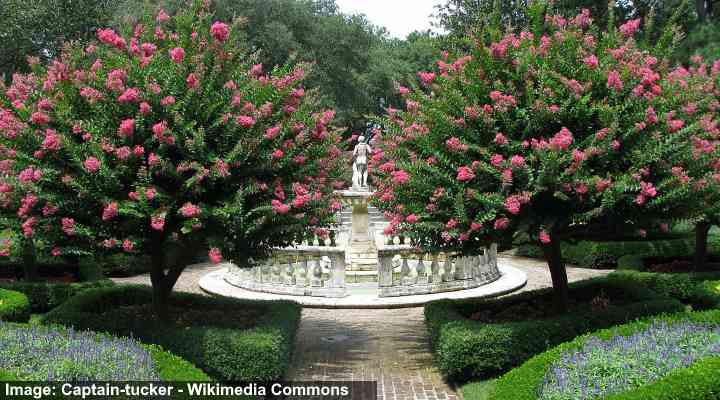
Large and small crape myrtle trees grow best as specimen trees and add a focal point to a landscaped garden
The ornamental crape myrtles belong to the Lagerstroemia genus of flowering trees and shrubs that thrive in warm climates. Popular in garden landscapes, crape myrtle trees produce masses of red, pink, purple, and white flowers throughout the summer.
Crape myrtle are shrub-like trees that have deciduous or evergreen foliage, colorful peeling bark, multiple stems, and a bushy growth habit. Most species of crape myrtle trees thrive in USDA zones 7 through 10.
Dwarf crape myrtle trees, ideal for compact gardens, are large shrubs typically growing between 6 and 10 ft. (1.8 – 3 m) tall. For instance, the ‘Acoma’ crape myrtle features a rounded spreading crown and is adorned with masses of white flowers. Other crape myrtle trees attain heights ranging from 15 to 20 ft. (4.5 – 6 m).
Further reading: Crape Myrtles: Trees, Dwarf Plants and Shrubs.
Mesquite Trees (Prosopis)
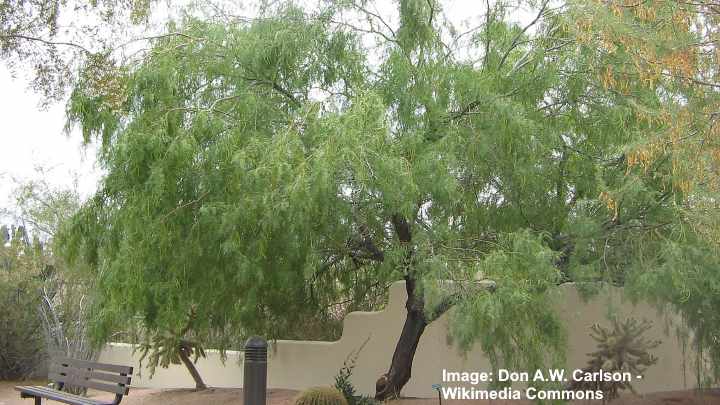
Honey Mesquite Tree (Prosopis glandulosa)
Mesquite refers to a variety of sizable deciduous shrub-like trees within the Prosopis genus of the Fabaceae pea family. Mesquite trees can range from a few feet in height to as tall as 50 ft. (15 m). Among the approximately 40 mesquite species, approximately seven are native to regions spanning Texas, California, and Northern Mexico.
Mesquite trees are short and thorny with feathery leaves, white or yellow flowers, and seed pods containing peas. The most common types of mesquite trees are the honey mesquite tree (Prosopis glandulosa), velvet mesquite tree (Prosopis velutina), and screwbean mesquite tree (Prosopis pubescens).
Mesquite trees thrive in USDA zones 7 through 11 in full sun and well-draining soil. You can find mesquite trees growing in deserts, grasslands, along streams, and on hillsides. Because of their fast growth and extensive root system, mesquite plants are considered invasive in some areas.
Further reading: Mesquite Trees: Types, Leaves, Flowers, Bark – Identification Guide.
Magnolia Trees
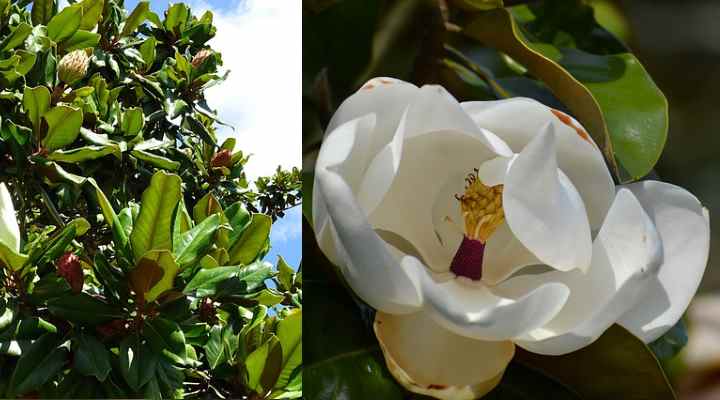
Southern Magnolia (Magnolia grandiflora)
Magnolia is a genus of large flowering shrubs or trees in the family Magnoliaceae. Magnolia grows as a multi-stemmed shrub or a single trunk tree. The beautiful landscape tree is characterized by its fragrant pink, purple, yellow, or white flowers, glossy leathery leaves, and cone-like fruits.
Magnolias can be deciduous or evergreen depending on their growing zone. There are about 125 species of magnolia suitable for growing in most zones. There are 8 species of magnolia native to the United States.
The most popular magnolia types are the Southern Magnolia (Magnolia grandiflora), Star magnolia (Magnolia stellata), and Saucer magnolia (Magnolia × soulangeana).
Most varieties of magnolia thrive in full sun or partial shade. Magnolia trees and shrubs adapt to various soil types and grow well as long as the soil is well-draining.
Further reading: Types of Magnolia Trees and Shrubs with Their Flowers and Leaves – Identification Guide.
Buckeye Trees (Aesculus)
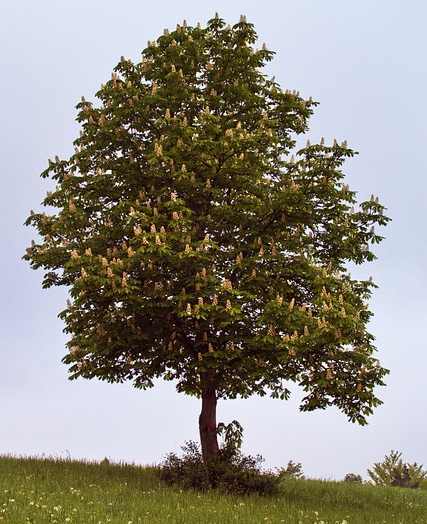
Buckeyes are deciduous ornamental trees that are popular in parks and open spaces
Buckeye is a variety of ornamental deciduous trees in the genus Aesculus and family Sapindaceae that is related to the horse chestnut tree. There are four main varieties of buckeye trees. Common varieties of buckeyes are the Ohio buckeye, the California buckeye, and the yellow buckeye.
Buckeye trees grow between 12 and 40 ft. (3.5 – 12 m) tall. You can find buckeyes growing in the deciduous forests and grasslands in the Midwest. They are also popular trees in parks and open spaces in states along the East Coast and the Southern states. Ohio buckeyes are found all the way from New York to Kentucky and down to Texas.
Buckeye trees are identified by their large round inedible nut-like seeds that look like the eye of a buck, green palmately compound leaves, and creamy-yellow or red flower clusters.
Further reading: Types of Buckeye Trees with Their Flowers and Leaves – Identification Guide.
Horse Chestnut Trees (Aesculus hippocastanum, Aesculus carnea)
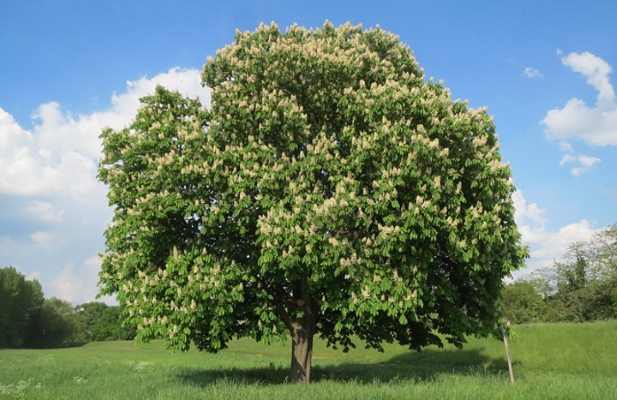
The horse chestnut tree (Aesculus hippocastanum) is a flowering deciduous tree commonly found in parks and open landscapes
The horse chestnut (Aesculus hippocastanumis) is a species of large deciduous flowering tree in the genus Aesculus. With its stout branches and oval to rounded crown, the tree grows 50 to 70 ft. (15 – 21 m) tall and up to 65 ft. (19 m) wide. Horse chestnuts grow in USDA zones 3 through 8.
The horse chestnut tree has green spiky seed balls containing a large, oval inedible brown seed like the nuts (seeds) from a buckeye tree. A horse chestnut tree is easy to identify in the landscape due to its large, rounded leaves, white-pinkish flowers growing in conical clusters, domed crown, and tall stature. Although too large for most gardens, horse chestnut trees are popular in parks and streets.
There are two primary varieties of horse chestnut trees: Aesculus hippocastanum and the red horse chestnut tree (Aesculus carnea), which is a smaller tree that grows 30 to 40 ft. (9 – 12 m) tall, and its rounded crown spreads up to 35 ft. (10 m) wide.

Red horse chestnut tree (Aesculus carnea)
The red horse chestnut is a hybrid tree of the Aesculus hippocastanum and Aesculus pavia (red buckeye). The red horse chestnut isn’t as tall as the regular horse chestnut, and it has deep red showy flowers rather than white ones.
The red horse chestnut is suitable for growing in USDA zones 5 through 8. Like most species of Aesculus, the leafy flowering tree performs well in full sun or partial shade. The attractive shade tree grows well in most soils that are well-drained.
Further reading: Horse Chestnut Tree: Leaves, Flowers, Bark (Pictures) – Identification.
Vitex Trees (Chaste Trees)
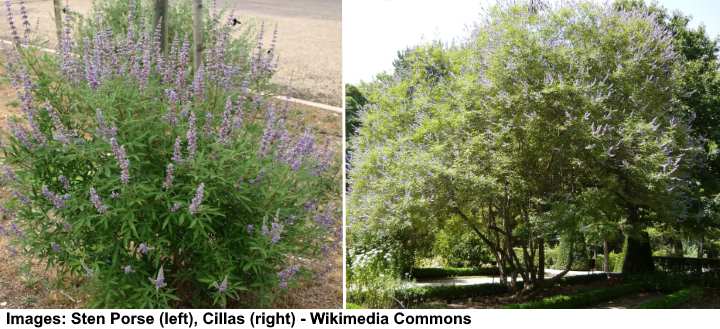
Vitex is a woody plant that can grow as a shrub (left) or as a multi-stemmed shrubby tree (right)
Vitex tree (also named chaste tree) is a large type of multi-stemmed shrub or small tree with attractive spikes of lavender-colored flowers that bloom in summer. Although referred to as the vitex tree or chaste tree, the vitex plant generally grows as a sizeable bushy shrub. But in warmer climates, vitex can grow as a small multi-trunked tree.
Chaste trees (Vitex agnus-castus) have many characteristics that make them desirable garden shrubs/trees. Apart from the clusters of small violet flowers, these plants have aromatic grayish-green, lanceolate leaves. The large deciduous shrubs/trees have a vase-shaped growth that spreads upward and outward.
Vitex trees grow best in USDA zones 7 through 9. In warmer climates, the large shrub can grow up to 15 ft. (4.5 m) tall and, as a tree, up to 20 ft. (6 m) tall. In zones 5 and 6, the shrubby plant experiences winter die-back. However, frost rarely affects the roots, and vitex bushes come back to life the following spring.
Further reading: Vitex Trees (Chaste Trees): Types, Flowers, Leaves, Care.
Larch Trees (Larix)
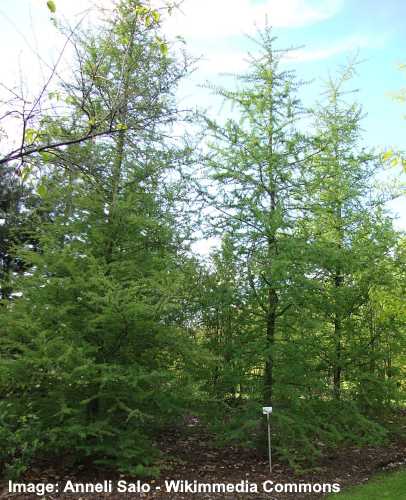
American Larch (Larix laricina) is a popular type of larch and is native to Canada and the northeastern states of the US
Larch is a species of deciduous, coniferous tree in the genus Larix and the pine family Pinaceae. There are between ten and twelve species of larch trees. The two most popular species of larch are the American Larch (Larix laricina)—also called tamarack—and the Western Larch (Larix occidentalis).
Larch trees are identified by their pyramidal growth, typical of most conifer species. However, unlike most conifers, larch trees turn golden yellow in the fall before dropping their leaves (needles). Larches are one of the few conifer trees to have bare branches with no foliage in winter.
Larch tree leaves are soft, flat, and needle-shaped, similar in appearance to many pine trees. Like all true conifers, larch is a cone-producing tree with male and female cones growing on the same tree.
Larch trees are tolerant of freezing temperatures, thriving in USDA zones 2 through 5.
Further reading: Larch Trees: Types, Leaves, Cones, Flowers – Identification Guide.
Alder Trees (Alnus)
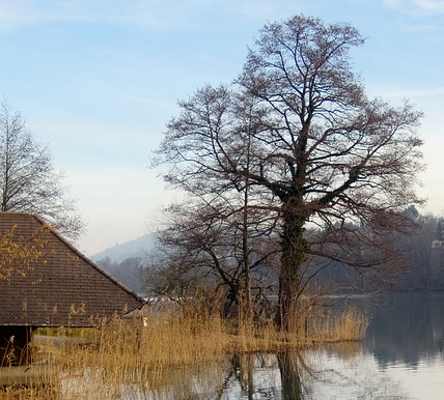
Alders are large deciduous trees that grow well in wet areas
Alder (Alnus) is a genus of flowering deciduous trees in the family Betulaceae. There are about 35 alder species, comprising of large trees and smaller shrub-like trees.
Alder trees are known for their drooping flower clusters and brown woody cones called strobiles. The alder cones develop from catkins (conical flower clusters) and stay on the tree throughout the winter, giving the bare branches a distinguishable look.
It’s easy to identify alders in landscapes due to their vast, rounded crown, serrated green leaves, and brown conifer-like cones.
Several species of alder trees are native to North America and Europe, with the Red Alder (Alnus rubra) and Black Alder (Alnus glutinosa) being the two most common.
Alders thrive in marshy, damp ground. Most alder species thrive in USDA zones 5 through 8; however, some individual species may be more or less cold-hardy.
Further reading: Alder Trees: Leaves, Bark, Flowers, Cones – Identification.
Sweetgum Trees (Liquidambar)
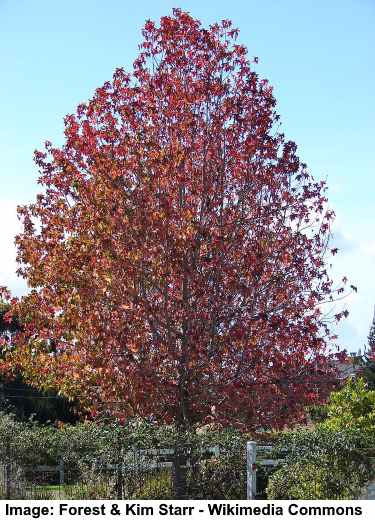
The American sweetgum tree (Liquidambar styraciflua) is also called the gumball tree
Sweetgums are ornamental flowering deciduous trees in the genus Liquidambar and the family Altingiaceae. You can find sweetgums growing in eastern North America from Connecticut to Florida and as far west as Texas, Missouri, and Oklahoma.
There are 15 species of sweetgum trees that reach a mature height between 32 and 130 ft. (10 – 40 m). Sweetgum trees get their name from the sweet, sticky, resinous substance that oozes from the cut trunk.
Identifying features of sweetgum trees are large lobed leaves that can be orange, red, yellow, or purple colors in the fall, small globular flowers, and seed-containing spiky gumballs measuring up to 2” (5 cm) across.
The American sweetgum (Liquidambar styraciflua), commonly known as the gumball tree, is the most popular sweetgum variety. It serves as a splendid shade or lawn landscaping tree.
Further reading: Sweetgum Trees (Gumball Tree, Liquidambar): Types, Leaves – Identification Guide.
Linden Trees (Tilia)
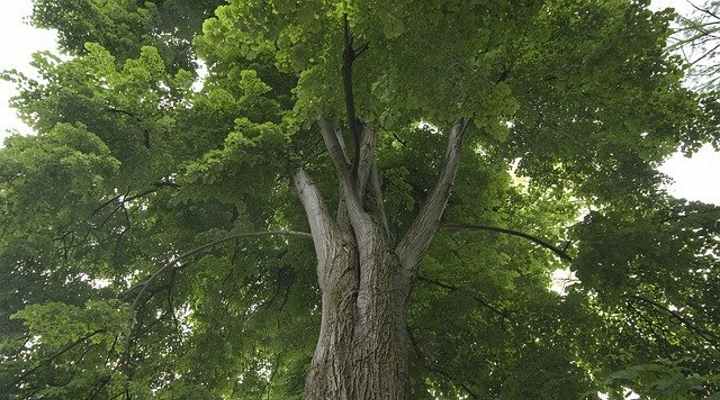
The flowering deciduous linden trees are typically large and suitable for landscaping spacious areas
Linden trees (genus Tilia and the family Malvaceae) are large deciduous shade trees with large heart-shaped broadleaves and clusters of fragrant yellowish-white flowers. In the fall, linden tree leaves turn a spectacular bright yellow color.
There are approximately 30 species of linden trees and shrubs that generally reach heights of 65 to 130 ft. (20 – 40 m) and widths of 50 ft. (15 m).
Linden trees can be identified by their thick furrowed trunks, rounded crown, dense leafy foliage, and pyramidal growth habit.
European linden trees are also called lime trees, and North American lindens are called basswood trees. They thrive in full sun to partial shade and moist soil with excellent drainage.
Further reading: Linden Trees: Types, Leaves, Flowers, Bark – Identification.
Basswood Trees
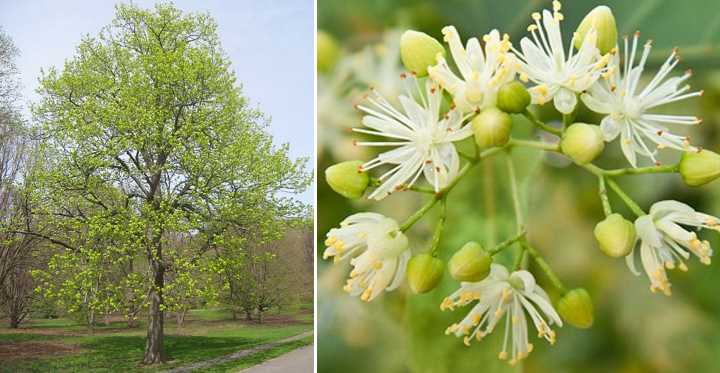
American Basswood trees (American Linden) thrive in USDA zones 3 – 8, but they may also grow in sheltered areas of zone 2
The main basswood tree species in North America is the American basswood (Tilia americana) which is also named American linden.
American basswood is a large, fast-growing deciduous tree with fragrant yellowish-white flowers. The basswood tree can be identified by its domed crown, and its large heart-shaped leaves with serrated edges and pointed tips. In fall, the leaves of deciduous basswood trees turn pale yellow to yellowish-green.
After blooming, the flowers of the basswood tree develop into basswood fruit. The small round nut-like balls measure up to 0.4” (1 cm) in diameter and dangle from long narrow leaf-like bracts.
The American basswood tree is a popular ornamental shade tree due to its dense foliage and spreading canopy. Popular American basswood cultivars include Carolina basswood, Redmond basswood and white basswood.
The American basswood tree is the only native North American species in the genus Tilia and is often found growing in eastern and central North America. Other tree species in the genus Tilia are known as linden trees.
Further reading: American Basswood Trees (American Linden): Types, Leaves, Flowers – Identification.
Aspen Trees (Populus)
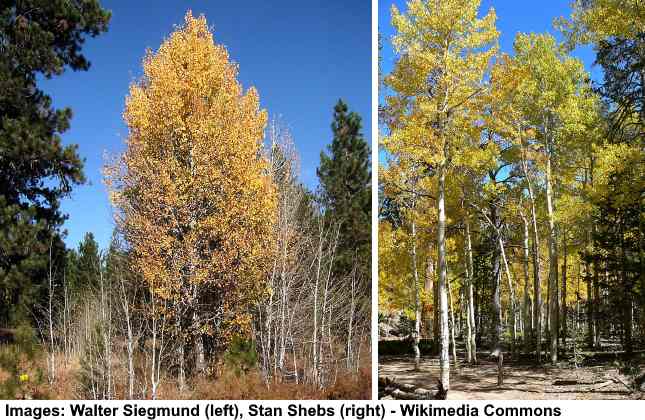
Quaking Aspen Tree (Populus tremuloides) is the main species of aspen growing in North America
Aspen trees are flowering medium-sized deciduous trees belonging to the genus Populus. Aspens are characterized by their straight, slender trunks with gray-white bark, round leaves with toothed margins, and clusters of dangling flower spikes called catkins.
The quaking aspen (Populus tremuloides) and bigtooth aspen (Populus grandidentata) are the most common aspen trees in North America. You can find aspens growing as far north as Alaska and as far south as Mexico.
Aspen trees have a unique spreading root system that produces new clone trees. You will often find smaller aspen trees growing alongside large, mature aspens as the tree suckers sprout up from the roots.
Aspen trees typically grow among coniferous trees in North America. Aspen trees are cold-hardy trees that thrive in USDA zones 2 through 8.
Further reading: Aspen Trees: Types, Leaves, Flowers – Identification.
Acacia Trees
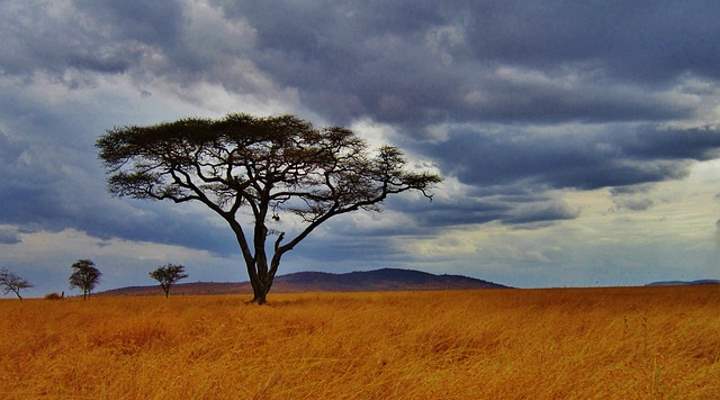
Acacia trees and shrubs can be of varying sizes and are tolerant of dry, arid conditions
Acacia thorny trees and shrubs are an evergreen plant species with unique fern-like leaves and showy clusters of fragrant yellow or white fuzzy flowers. Acacia fruit looks like peapods that can be straight, coiled, or twisted. The pods grow in clusters on acacia trees and can be green, brown, or black.
Many species of Acacia are native to Australia, and some are native to Africa. In North America, acacias grow in warm states such as Texas, Arizona, and California.
Also called wattles, acacia trees grow best in full sun and well-draining, loamy, or sandy soil. The drought-tolerant plant hardly needs any water after it’s established in the landscape. It’s a trouble-free, low-maintenance evergreen tree that doesn’t require much care.
Acacia trees are fast-growing and relatively short-lived trees that grow between 20 and 30 years.
Species of trees and shrubs in the genus Acacia thrive in USDA growing zones 9 through 11.
Further reading: Acacia Trees: Types, Leaves, Flowers, Thorns – Identification.
Beech Trees (Fagus)
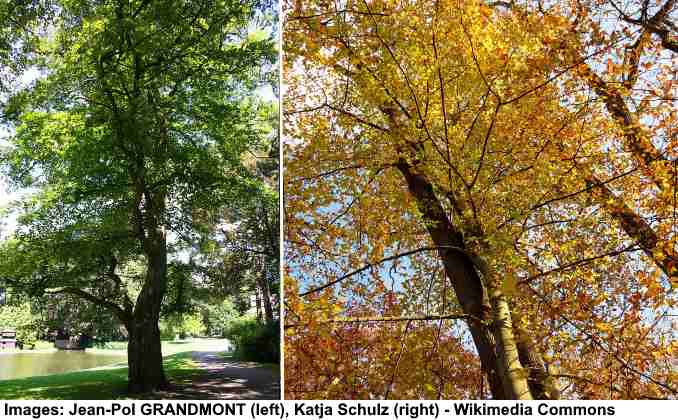
American Beech Tree (Fagus grandifolia)
Beech trees (botanical name Fagus) are tall deciduous shade trees with green ovate leaves with finely toothed margins, creating a dense, rounded crown. In the fall, beech tree foliage turns from green to beautiful autumn shades of orange, yellow, and golden brown.
All varieties of beech trees produce small clusters of yellow-green flowers (catkins), followed by beech tree unique looking fruit or beechnuts. The fruit (nuts) from beech trees are triangular in appearance and are contained in spiky husks called cupules.
The most common types of beech trees are the American beech tree (Fagus grandifolia) and the European beech tree (Fagus sylvatica).
Beech trees are easy-care, versatile trees that thrive in various conditions. Native to temperate climates in North America and Europe, beech trees grow in rich, fertile soil with excellent drainage.
Further reading: Beech Trees: Types, Leaves, Bark — Identification Guide.
Catalpa Trees
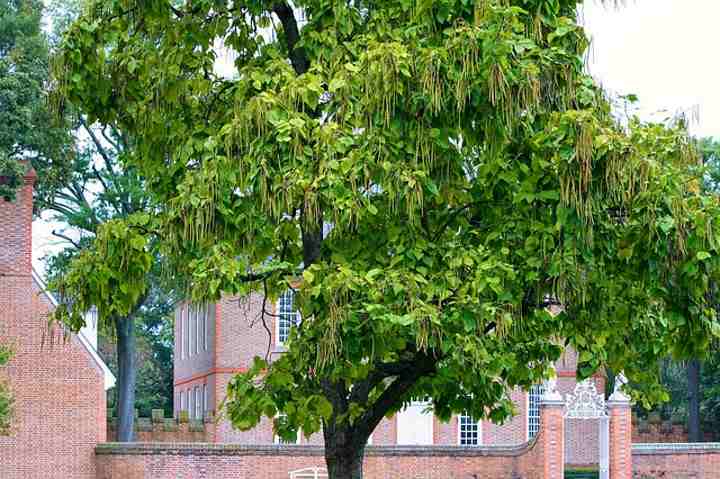
Catalpa tree is identified by its long and slender seed pods
Catalpa trees are deciduous ornamental shade trees with large, heart-shaped or triangular leaves. The flowering trees have white or yellow fragrant flowers, and long, slender dangling seed pods. The seed pods appear in the fall and persist until winter or even spring. The unusual masses of long seed pods on catalpa trees look green and gradually turn dark brown.
Two species — the northern catalpa (Catalpa speciosa) and southern catalpa (Catalpa bignonioides) — are native to North America. The other common type of catalpa tree is the Chinese catalpa (Catalpa ovata), which is native to China.
Catalpa trees are typically fast-growing trees that grow best in full sun and are adaptable to growing in various soil types.
Further reading: Catalpa Tree: Types, Leaves, Flowers, Seed Pods.
Serviceberry Trees (Amelanchier)
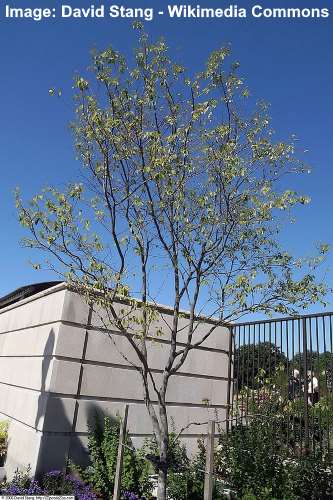
Autumn Brilliance Apple Serviceberry Tree (Amelanchier × grandiflora ‘Autumn Brilliance’)
Serviceberry is a group of small deciduous fruit trees or multi-stemmed shrubs with beautiful white flowers that bloom in early spring. Serviceberry trees and shrubs are identified by their long oval leaves with finely serrated edges, clusters of showy white 5-petalled flowers, smooth gray bark, and small round edible purple pome fruits. Serviceberry trees are excellent garden landscaping plants because they have a visual appeal in all four seasons.
There are 20 species of deciduous trees and shrubs in the genus Amelanchier and the rose family Rosaceae. Serviceberries are native to North America and grow widely throughout the United States and Canada.
Serviceberry trees flourish in full sun to partial shade within USDA zones 4 to 9. They typically reach heights of 10 to 25 ft. (3 – 7.5 m) and can spread up to 20 ft. (6 m) wide. Given its multi-stemmed nature and tendency to produce suckers, it’s essential to remove suckers when growing serviceberry as a tree, preventing it from becoming a dense shrub.
Further reading: Serviceberry: Trees, Shrubs, Leaves, Flowers – Identification.
Tulip trees (Liriodendron)
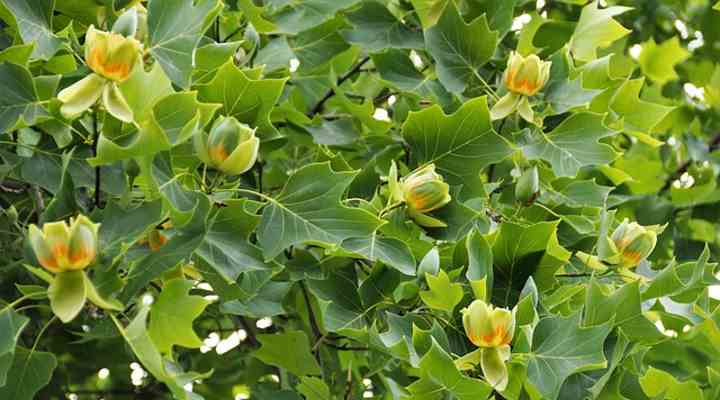
Tulip tree flowers are not easily spotted among the green foliage
Tulip trees are flowering deciduous trees in the genus Liriodendron and the magnolia family Magnoliaceae. The two species of tulip trees are the American tulip tree (Liriodendron tulipifera) and the Chinese tulip poplar (Liriodendron chinense).
Also called the tulip poplar or tuliptree, these impressive trees are easy to identify in landscapes with their straight trunk, oval or pyramidal canopy, yellow-green flowers, and beautiful golden yellow fall colors. The cup-shaped or trumpet-like flowers appear in late spring and complement the bright green, unusually shaped leaves. Being a type of deciduous tree, the tulip poplars lose their leaves in the fall when the foliage turns golden yellow.
Tulip trees thrive in USDA zones 4 to 9. They grow between 60 and 160 ft. (18 – 50 m) tall and have a pyramidal crown measuring 30 to 50 ft. (9 – 15 m) wide in their native habitat. Tulip trees are relatively fast-growing but grow for between 15 and 20 years before the trees produce flowers.
An issue with growing tulip poplars in garden landscapes is that they can be messy. Apart from their enormous size, the flower petals and autumn leaves can litter the ground. Additionally, the trees secrete a sticky sap that sticks to cars, paths, and driveways.
Further reading: Tulip Trees (Tulip Poplar): Leaves, Flowers, Bark – Identification.
Sumac Trees (Rhus)
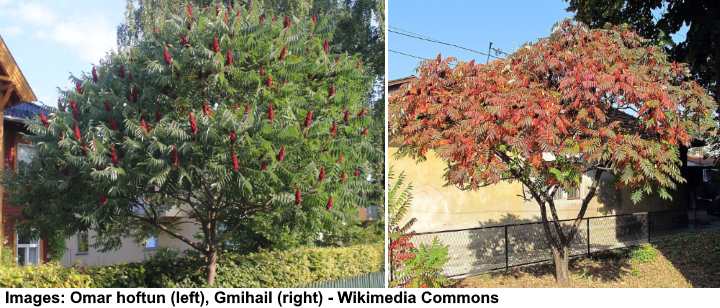
Staghorn sumac (Rhus typhina)
Sumac (genus Rhus) is a group of flowering small trees and shrubs. Sumacs are identified by their fern-like pinnate leaves, conical clusters (panicles) of white or green flowers, and fuzzy red berries. In the fall, sumac trees and shrubs turn brilliant autumn shades of red, orange, or purple.
There are around 150 species of sumac, with 14 being native to the US. Sumac trees and shrubs grow in most soil types and are often seen growing in dry and poor soil.
Native North American sumac trees grow in USDA zones 3 through 9. Trees and shrubs in the genus Rhus grow between 3 and 33 ft. (1 – 10 m).
Sumac trees such as the staghorn sumac (Rhus typhina), smooth sumac (Rhus glabra), and fragrant sumac (Rhus aromatica) produce edible red berry-like drupes. Most species of sumac are deciduous trees that lose their leaves in the fall. The native tobacco sumac (Rhus virens) is an evergreen variety with glossy green, leathery leaves.
A characteristic of sumacs is their suckering growth habit. This feature means that sumacs can grow as multi-stemmed shrubs if you don’t remove the suckers.
Further reading: Sumac Trees: Types, Leaves, Berries – Identification Guide.
Hackberry Tree (Celtis)
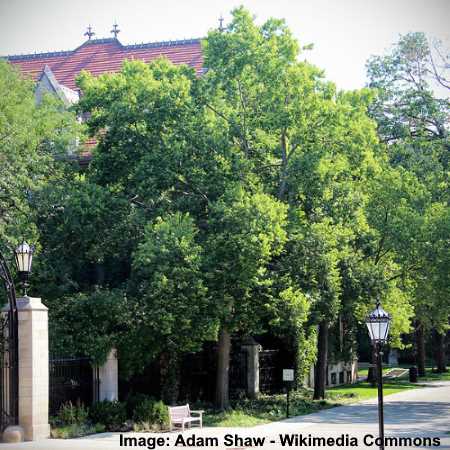
Common Hackberry Tree (Celtis occidentalis)
Hackberry (Celtis) is a group of medium-sized, deciduous trees with long ovately-shaped leaves, clusters of small fuzzy spring flowers, and small purple fruits. Low-maintenance hackberry trees are hardy trees that withstand many conditions, including drought, wet soil, strong winds, and air pollution.
The common hackberry tree (Celtis occidentalis) grows 40 to 60 ft. (12 – 18 m) high and wide. The attractive landscape tree has a pyramidal crown when immature. As the tree grows, the tree develops an open, spreading canopy of arching zigzag branches.
Hackberry bark is its most recognizable feature. The smooth light brown or grayish bark has characteristic wart-like growths, ridges, and a corky texture giving the tree’s bark a distinctive pattern.
The common hackberry is native to many states in the Midwest and Eastern areas of North America. In addition, some species of hackberry, like the sugarberry (Celtis laevigata), are common in Texas and other warm states in the south.
Most hackberry trees thrive in USDA zones 2 to 9. The sugarberry—or southern hackberry—grows best in zones 5 to 10.
Further reading: Hackberry Trees (Celtis): Common Types, Leaves, Bark, Fruit – Identification.
Mulberry Trees (Morus)
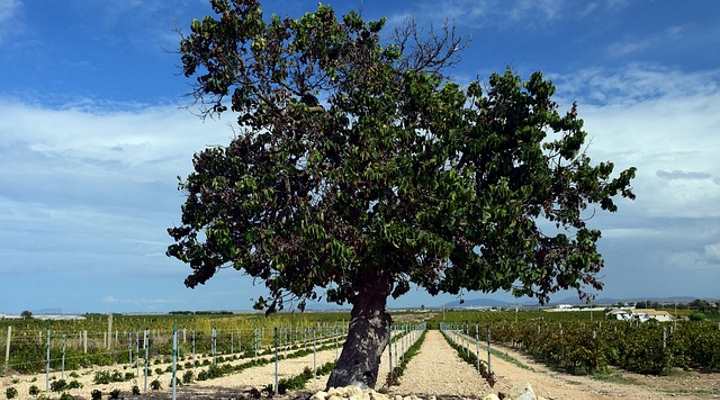
Old mulberry tree
Mulberry trees (botanical name Morus) are popular deciduous trees that produce delicious edible white, red, or black berry-like fruits. Commonly called mulberries, the medium-sized, berry-producing trees have attractive heart-shaped leaves, spikes of tiny white flowers (catkins), and thick grayish-brown bark.
The common species of mulberry trees are red mulberry (Morus rubra), white mulberry (Morus alba), and black mulberry (Morus nigra). They thrive in USDA zones 4 through 9, full to partial sun, and well-drained soils. In addition, the mulberry tree is relatively resistant to pests and disease.
The mature size of the mulberry tree depends on the species. White mulberry is the tallest at 80 ft. (24 m), and the common red mulberry grows up to 70 ft. (21 m). The black mulberry is the smallest species, with a height of around 30 ft. (9 m).
Additionally, there are many mulberry cultivars, such as the weeping mulberry tree (Morus alba ‘Pendula’), fruitless mulberry tree, and dwarf mulberry tree which is ideal for containers, and grows 2 to 6 ft. (0.6 – 1.8 m) tall.
Further reading: Mulberry Trees: White, Red, Black with Flowers and Leaves.
Mimosa Trees (Albizia Julibrissin)
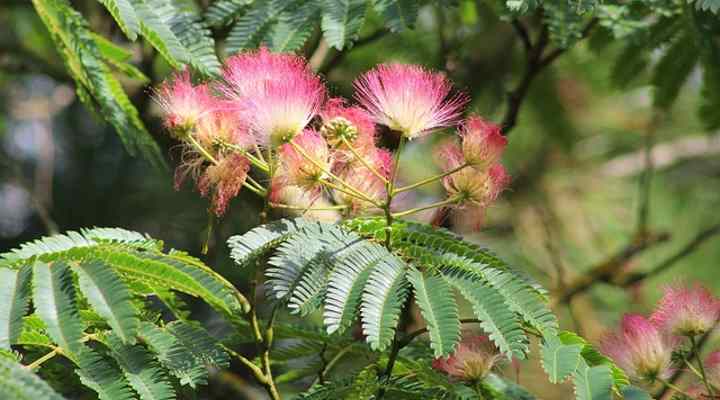
Mimosa tree flowers and leaves
The mimosa tree (also known as the Persian silk tree) is a rapidly growing ornamental tree featuring silky pink pompom-like fluffy flowers, fern-like leaves, and flat, brown bean-like seed pods. This deciduous, medium-sized tree belongs to the Albizia genus within the Fabaceae legume family. A mature mimosa tree can reach heights of 10 to 50 ft. (3 – 15 m) and span up to 50 ft. (15 m) in width
Mimosa trees are native to Asia and thrive in warm climates in USDA zones 6 through 10. These trees have a rapid growth rate, growing around 3 ft. (1 m) per year and can be invasive. However, they are short-lived trees. Their average lifespan is only 30 years. Additionally, the trunk and branches are weak and brittle and easily break in strong winds.
Mimosa trees grow well in containers and are excellent patio, deck, or balcony plants. Keeping them in a large container and pruning will limit their height.
The Chocolate mimosa tree (Albizia julibrissin ‘Summer Chocolate’) is not as invasive as other varieties. It is a small deciduous tree with chocolate-burgundy foliage that grows between 15 and 20 ft. (4.5 – 6 m) tall and up to 20 ft. (6 m) wide.
Further reading: Mimosa Trees (Albizia Julibrissin): Facts, Flowers, Leaves.
Yew Trees (Taxus)
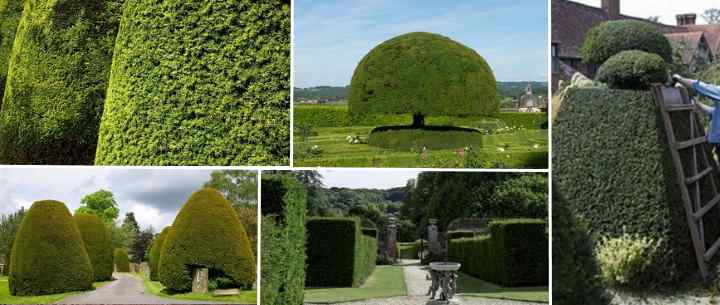
Yew trees, characterized by their dense evergreen foliage, thrive with pruning and serve excellently as privacy hedges or topiaries
Yew (botanical name Taxus) is a genus of slow-growing coniferous evergreen trees and shrubs. Yews are typically long-lived trees that can live for hundreds or even thousands of years. Ornamental yew trees grow between 35 and 65 ft. (10 – 20 m) tall and up to 20 ft. (6 m) wide.
Yews are cold-hardy evergreen trees that thrive in USDA zones 3 to 7. Yews can grow in temperatures as low as -13°F (-25°C); however, the shade-loving trees don’t perform well in prolonged hot temperatures.
Yews are identified by their thin, scaly brown bark, tiny single-seed cones, red fruits, and linear flat leaves. The English yew (Taxus baccata) is the most common species. But Irish yew, Western yew, and Japanese yew are also ornamental conifer trees.
If you want to plant a yew tree as a tall hedging plant, it is best to choose a shaded spot because the evergreen trees grow well in partial sun or deep shade. Ensure that the ground is well-draining and protect yew trees from heat, drought, and full sun for more than six hours a day.
Further reading: Yew Trees: Types, Berries, Leaves – Identification.
Sassafras Trees
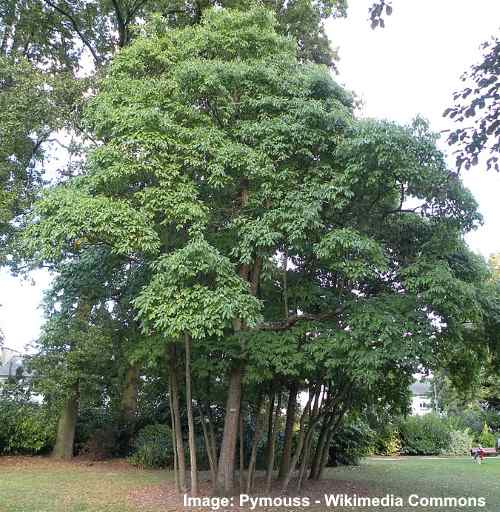
Sassafras albidum
Sassafras is a group of deciduous trees with three species of sassafras native to North America and Asia—Sassafras albidum, Sassafras randaiense, and Sassafras tzumu. The common Sassafras albidum matures at 30 to 60 ft. (9 – 18 m) tall and 25 to 40 ft. (7.6 – 12 m) wide.
However, the shrub-like tree also has suckering tendencies and can quickly become a large multi-stemmed shrub. In open woodlands, it’s not unusual to see colonies of sassafras that are all connected to the same parent tree.
Sassafras trees thrive in USDA zones 4 to 9. The trees are commonly found on the east coast of the United States. Sassafras trees grow best in full sun to partial shade. In garden landscapes, sassafras trees thrive in well-drained, acidic soil. In ideal conditions, sassafras trees are fast-growing trees that grow between 12” and 24” (30 – 60 cm) a year.
Recognizable features of sassafras trees are unusually lobed leaves, clusters of golden-yellow flowers, and dark blue berry-like drupes. Sassafras trees are also highly aromatic trees. In fall, when the foliage turns spectacular orange, scarlet, yellow, and purple colors, the leaves give off a strong fragrance. In the spring, the blossoms smell of root beer. Sassafras trees are relatively fast-growing trees that grow between 12” and 24” (30 – 60 cm) a year.
Further reading: Sassafras Tree: Leaves, Flowers, Bark – Identification Guide.
Chokecherry Tree (Prunus virginiana)
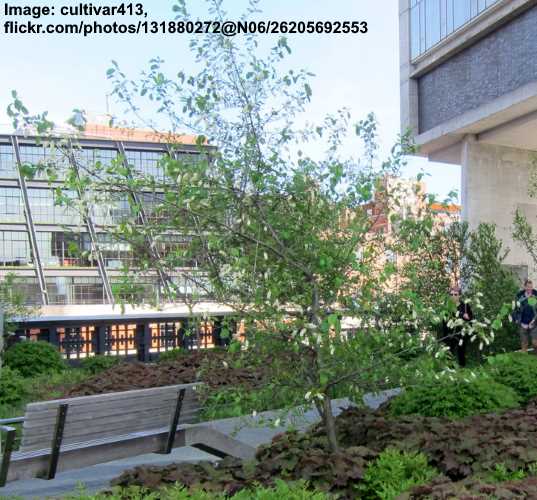
You can remove suckers around the central trunk to grow a single-stemmed chokecherry tree
Chokecherry (Prunus virginiana) is a small deciduous tree or multi-stemmed shrub that sends up suckers. Typically, chokecherry trees grow between 3 and 20 ft. (1 – 6 m) tall and up to 20 ft. (6 m) wide. However, it’s not unusual for some chokecherry trees to reach 30 ft. (9 m) tall.
The fruit-bearing chokecherry trees or shrubs are common throughout the northern states of the US and Canada. Chokecherry trees are known for their tart, bitter, berry-like drupes and are used to make jams and jellies. The tart flesh of Chokecherry fruit is edible, however don’t eat the seeds that contain toxins.
Identifiable features of chokecherry trees are relatively smooth gray bark, glossy green egg-shaped leaves, white spring flowers, and dark red or black summer fruits.
As a cold-hardy shrub or tree, the chokecherry thrives in USDA zones 2 through 10. The attractive flowering plant grows best in full sun or part shade, and when established, chokecherry is tolerant of drought.
Further reading: Chokecherry Tree: Leaves, Chokecherries, Flowers – Identification.
Plumeria Tree (Frangipani)
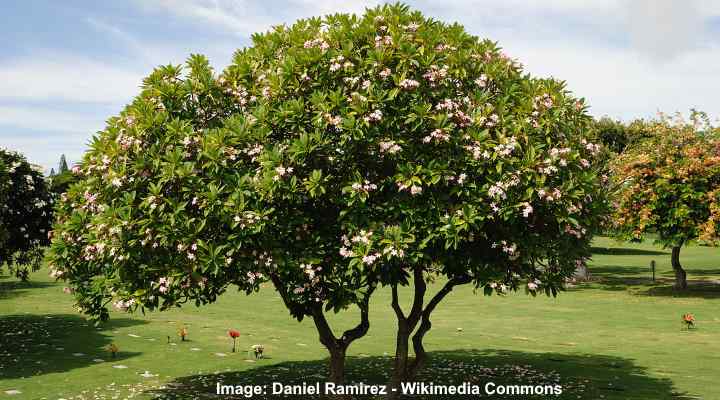
Plumeria tree
Plumeria comprises a collection of small flowering trees or shrubs renowned for their highly scented, exotic, and showy star-shaped flowers. These blossoms have an array of colors including white, yellow, pink, red, and multi-tones.
Also known as frangipani, these tropical trees fall into the categories of deciduous or semi-evergreen trees or shrubs. Notably, a few plumeria species, such as Plumeria obtusa and Plumeria pudica, retain their evergreen foliage. Flourishing predominantly in USDA zones 9 through 12, these striking flowering trees are commonly found in Florida, the Caribbean, the Pacific islands, Mexico, and Central America.
Frangipani trees are moderate to fast-growing plants that can grow up to 20 ft. (6 m) tall. However, in most tropical and subtropical garden landscapes, the exotic trees reach between 6 and 8 ft. (1.8 – 2.4 m) tall.
The only care plumeria trees require is plenty of sunlight, well-drained soil, water, and fertilizer.
Further reading: Plumeria Tree: Growing and Care Guide.
Ginkgo Biloba Tree
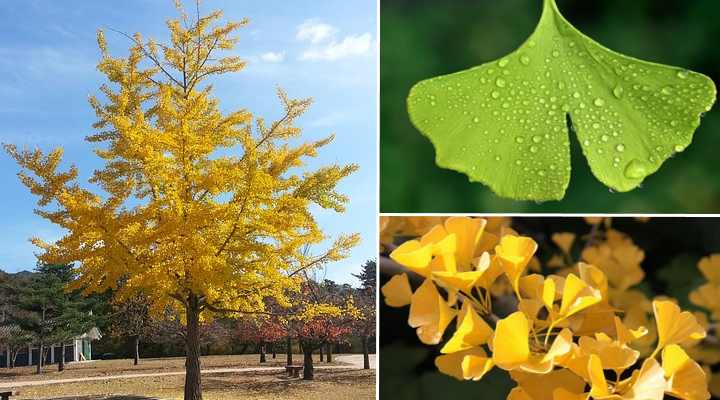
Ginkgo trees have a unique leaf shape that helps identify them
The Ginkgo biloba tree is a slow-growing, deciduous ornamental tree, distinguished by its large fan-shaped leaves that transform into a striking buttery-yellow hue during the autumn. Ginkgo biloba stands as the sole remaining species within the Ginkgo genus and the Ginkgoaceae family.
Ginkgo trees grow 50 to 75 ft. (15 – 23 m) with a broadly spreading pyramidal crown that grows up to 60 ft. (18 m) wide. However there are many varieties and smaller cultivars.
Also called the maidenhair tree, the ginkgo tree thrives in loamy, well-drained soil, full sun to partial shade, and in growing zones 3 to 9.
A male ginkgo tree is recognized by its long, drooping, flower-like cones that ‘bloom’ in mid-spring. Meanwhile, the female ginkgo tree is distinguished by its dangling clusters of orangey, globular fruits. Each of these rounded fruits houses a single large seed.
The main complaint of the ginkgo tree is the offensive stink from the fruit. Also, the slimy flesh of the female ginkgo fruit is particularly messy. If you have a small, compact garden, it’s best to choose male dwarf cultivars.
Further reading: Ginkgo Tree: Identification and Growing Guide.
Holly Tree (Ilex)
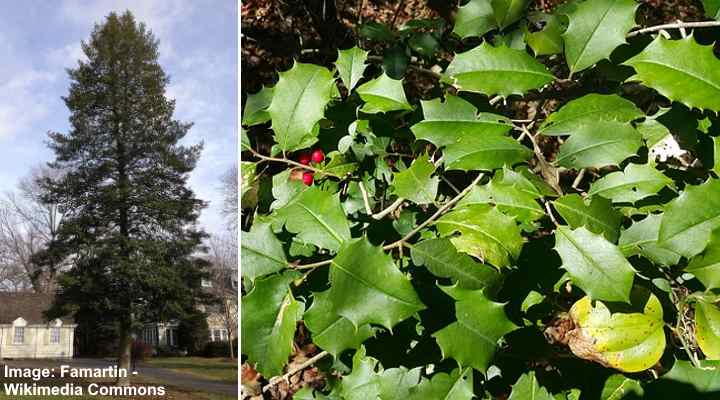
American holly tree (Ilex opaca)
Holly plants belong to the genus Ilex and the family Aquifoliaceae. The various types of hollies include large trees, bushy shrubs, and dwarf cultivars.
Holly trees can grow between and 30 and 80 ft. (10 – 24 m) tall. However, holly bushes typically grow up to 6 ft. (1.8 m) tall and are multi-stemmed plants.
Although most species of hollies are evergreen plants, there are some deciduous hollies that drop their leaves in winter. The most common holly species are the American holly (Ilex opaca) and the English holly (Ilex aquifolium). Both of these evergreen holly trees are famous for their shiny, jagged leaves and winter red berries.
Holly leaves are typically ovate or oblong, glossy green with wavy margins that are spiked, serrated, or smooth. Some of the most spectacular varieties of holly trees and bushes are variegated cultivars. The inedible berry-like fruits of holly are usually red but can be other colors, such as yellow and black.
Further reading: Holly Trees and Bushes: Identification Guide.
Chestnut Trees (Castanea)
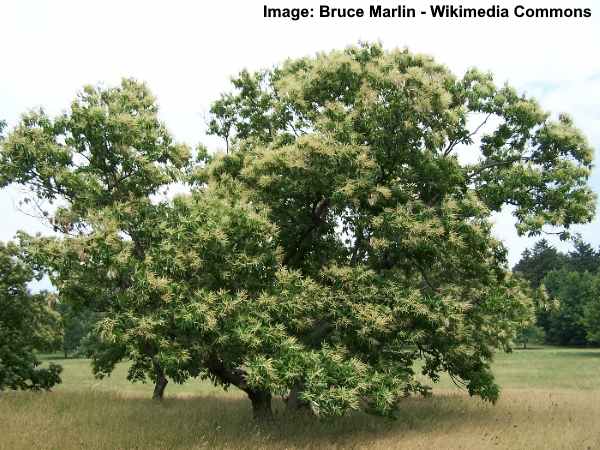
American chestnut tree (Castanea dentata)
Chestnut trees are large deciduous trees with large, pointed leaves with coarsely toothed margins, long finger-like flower clusters (catkins), and brown edible nuts.
Chestnuts are easily identifiable due to the spiky burs growing in clusters and containing the fruit—a brown-shelled nut encasing creamy-white flesh. Chestnut trees have a straight, broad trunk with deeply furrowed bark and a large spreading rounded canopy.
Chestnut trees trees predominantly thrive in temperate regions, typically found in USDA zones 5 to 7. They thrive in full sun and prefer loamy, well-draining soil.
Species of chestnut trees belong to the Castanea genus and the Fagaceae beech family.
The American chestnut (Castanea dentata) used to be in the timber industry, however due to chestnut blight fungal disease it is almost extinct in the wild now. It can grow up to 75 ft. (22 m) tall and wide.
Further reading: Chestnut Trees – Identification Guide.
Redwood trees
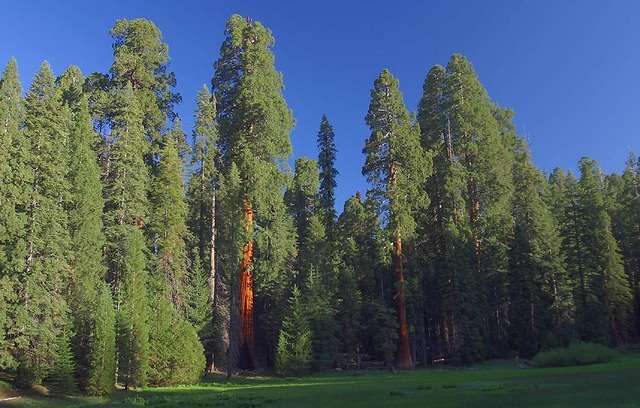
Redwood trees
Redwood trees are the largest and tallest trees on the planet. Redwoods are famous for their towering stature, with the tallest trees reaching 360 ft. (110 m) tall.
Two evergreen redwood species are native to California: California redwood/coastal redwood (Sequoia sempervirens) and giant redwood/sequoia (Sequoiadendron giganteum). The deciduous dawn redwood (Metasequoia glyptostroboides) is native to China.
Sequoias are the largest trees in the world in terms of volume, and they have immense trunks. Redwoods are the tallest trees and have slender trunks.
Redwoods require humid conditions with substantial rainfall in spring, fall, and winter. In addition, the foggy conditions common along the northern Pacific coast allows redwoods to thrive.
As coniferous trees, redwood trees produce seed-bearing cones, green needle leaves, and tiny yellowish-brown flowers. The cinnamon-red or reddish-brown bark is one way to identify redwood trees.
Further reading: Redwood Trees: Types, Facts and Identification.
Orchid Tree (Bauhinia)
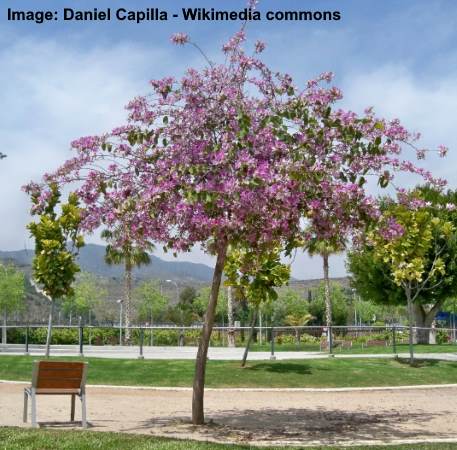
Variegated orchid tree (Bauhinia variegata)
The orchid tree is a genus of flowering shrubs and trees in the genus Bauhinia and the family Fabaceae. Orchid trees are native to Asia and commonly grow in India, China, Sri Lanka, and Vietnam. Some orchid tree species also grow in the wild in Texas in the Anacacho mountains.
Orchid trees are fast-growing large tropical shrubs or trees that reach a height of 20 to 40 ft. (6 – 12 m) with a spread of 10 to 20 ft. (3 – 6 m). The trees are famous for their brightly colored orchard-like flowers that bloom in winter and persist until early summer.
The flowers of orchid tree are beautiful pink, red, orange, yellow, white, or purple flowers resembling flowers growing on orchid plants. After flowering, the tree develops long, flat brown seed pods, common of many trees in the pea family Fabaceae. In addition, orchid trees have distinctive leathery, double-lobed green leaves that resemble the print of a cow’s hoof.
Some species of orchid trees are evergreen trees. Still, others are deciduous trees that drop their leaves during the dry season or in winter.
Orchid trees thrive in the warm regions of USDA in zones 9 to 11. Although some varieties of orchid trees survive a light frost, they are generally heat-loving trees that thrive in full sun and moist soils. The minimum temperature to grow orchid trees is 22°F (-6°C).
Further reading: Orchid Tree (Bauhinia): Types and Care Guide.
Tabebuia Tree (Trumpet Tree)
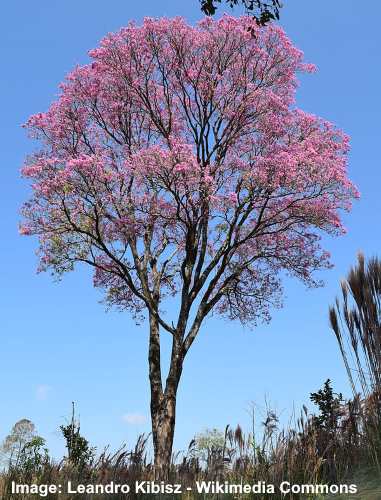
Tabebuia impetiginosa (Pink Trumpet Tree)
The tabebuia tree, also called the trumpet tree, is a spectacular flowering tree with pink, light purple, or bright yellow flowers.
Tabebuia trees flourish in hot climates, where these deciduous trees enhance garden landscapes with vibrant colors, captivating fragrances, and exquisite beauty. These small to medium-sized trees are effortless to cultivate in full sun, whether as ornamental or shade trees, and they also thrive when grown in containers.
The most common varieties of tabebuia tree grow around 15 to 30 ft. (4.5 – 9 m) tall and 40 ft. (12 m) wide. However, some species can reach heights of 60 ft. (18 m).
Some botanists give the tree the botanical name Handroanthus. However, Tabebuia is still an accepted and well-known name for this tropical tree. The common name trumpet tree refers to the spectacular blooms that appear throughout the summer.
Tabebuia trees thrive in warm, humid climates. The leafy deciduous flowering tree performs best in USDA zones 10 and 11.
To identify a tabebuia tree, observe its leathery, oval or oblong, palmately compound leaves, along with the striking trumpet flowers that hang in clusters. The bark is slightly rough, fissured, and tan-colored. Tabebuia leaves are dark glossy green, composed of five to seven leaflets. The tree is known for its abundant, characteristic showy pink, pale purple, or yellow flowers that flourish in large clusters.
Further reading: Tabebuia Tree: Types, Leaves, Flowers (with Pictures) – Identification.
Zelkova Tree
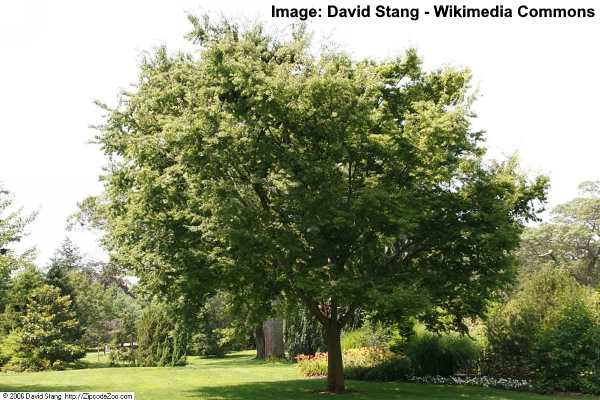
Zelkova serrata tree (Japanese zelkova)
Zelkova is a genus of deciduous trees in the elm family Ulmaceae. There are six species of zelkova trees and various cultivars. The common Zelkova serrata tree is the most common and grows up to 100 ft. (30 m) tall. However, zelkova tree cultivars are typically smaller and grow between 10 and 80 ft. (3 – 24 m).
The popular Zelkova serrata tree is native to Japan, China, Taiwan, and Korea. This is a reason why the leafy ornamental tree has the common name Japanese zelkova. Furthermore, because the zelkova trees are related to elms, the tree also goes by the name Japanese elm.
Part of the popularity of zelkova trees is that they are tolerant of a range of conditions. The shade tree with its bushy green foliage tolerates urban conditions, making it ideal as a street tree or ornamental residential tree. In addition, the graceful zelkova tree is tolerant of drought, wind, and heat.
Identify a zelkova tree by its short central trunk and spreading branches forming a vase-shaped crown. Zelkovas have grayish-white peeling bark revealing light orange inner bark. Large green serrated ovate leaves turn shades of red, orange, and yellow in the fall. Yellowish insignificant flower clusters and nut-like drupes grow on the tree.
Zelkova trees are cold-hardy in USDA zones 5 to 8.
Further reading: Zelkova Trees: Types, Leaves, Bark – Identification.
Kentucky Coffee Tree (Gymnocladus Dioicus)
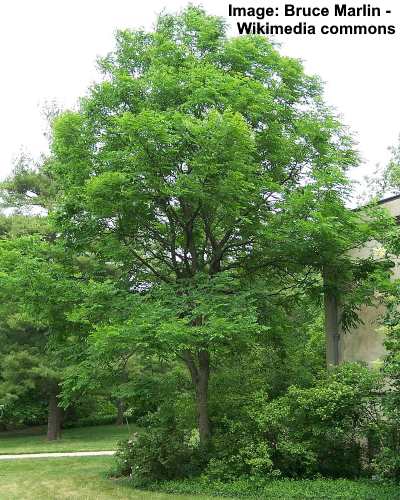
Kentucky Coffee Tree (Gymnocladus Dioicus)
The Kentucky coffee tree is the only native tree in the genus Gymnocladus in the legume family Fabaceae. The Kentucky coffee tree got its name from the coffee-like beverage you can brew from the roasted seeds.
The attractive deciduous tree with its open, irregular crown grows between 60 and 70 ft. (18 – 21 m) and 40 to 50 ft. (12 – 15 m) wide.
The Kentucky coffee tree is a popular ornamental tree, thanks to its appearance and growth habit. It has pinnate green leaves that turn bright yellow in the fall, greenish-white flowers, and large reddish-brown seed pods. Native to the Midwest, the Kentucky coffee tree is identified by its irregular oval crown with open branches that provide partial shade. Additionally, scaly gray-brown furrowed bark and reddish-brown twigs help identify the tree in winter.
Male trees tend to cause less mess as they don’t produce seed pods, making them suitable for planting in a residential landscape. Additionally, the Kentucky coffee tree is tolerant of drought and urban air pollution.
Kentucky coffee trees are relatively hardy deciduous trees that thrive in USDA zones 3 through 8. The coffeetree performs well in full sun and fertile, well-drained soils. However the tree performs just well in compacted clay soil as in sandy, loamy soil.
Further reading: Kentucky Coffee Tree – Identification and Care.
Hornbeam Tree (Carpinus)

American hornbeam (Carpinus caroliniana) tree
Hornbeam trees constitute a group of deciduous, flowering hardwood trees adorned with slender clusters of green-yellowish flowers, known as catkins. These ornamental landscape trees have a broad canopy and dark green, ovate leaves distinguished by serrated margins. These leaves transition to a beautiful golden yellow in the fall.
Common species of hornbeam trees, such as the American hornbeam (Carpinus caroliniana) and European hornbeam (Carpinus betulus), are popular in home garden landscapes and parks.
The most popular hornbeam cultivar is the ‘Fastigiata’ European Hornbeam (Carpinus betulus ‘Fastigiata’). This columnar landscape tree has a pyramidal shape and dense canopy, making it ideal for growing as a hedge plant, privacy screen, or natural fence. The ‘Fastigiata’ hornbeam grows 30 to 40 ft. (9 – 12 m) tall with a narrow habit of 15 to 20 ft. (4.5 – 6 m) wide.
Hornbeam trees have relatively slow growth and have an average growth rate of 12” (30 cm) per year. Growing for between 50 and 150 years, the American hornbeam tree reaches an average mature height of 20 to 30 ft. (6 – 10 m). The European hornbeam has an average height of 40 to 60 ft. (12 – 20 m).
Hornbeam trees thrive in full sun or partial shade and grow in most types of soils, as long as they are well-drained. The hardy American hornbeam trees grow well in USDA zones 3 through 9. The European hornbeam is winter hardy in zones 4 to 7.
Further reading: Types of Hornbeam Trees – Identification.
Purple Leaf Plum Trees (Prunus cerasifera)
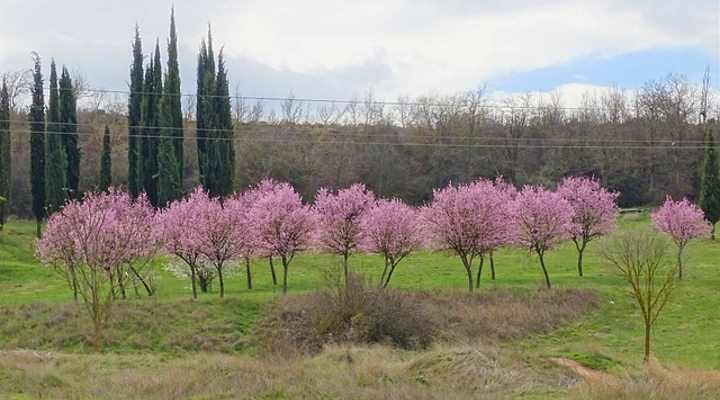
Purple leaf plum trees (Prunus cerasifera) are also called cherry plum trees
The purple leaf plum tree is a beautiful ornamental flowering tree with dark burgundy or purple leaves, fragrant whitish-pink spring blossoms, and an attractive shape. Also called the cherry plum tree, the purple leaf tree also produces small plum-like yellow or red edible fruit.
The purple leaf plum tree grows between 15 and 25 ft. (4.5 – 8 m) tall and thrives in USDA zones 4 through 9. The easy-to-grow landscape tree grows best in moist but well-drained soil that is moderately fertile. The attractive dark foliage tree performs well in full sun and can tolerate some shade. However, too much shade causes the leaves to turn green.
The cherry plum tree ‘Purple Pony’ is suitable for small, compact gardens. This dwarf plum tree grows 10 to 12 ft. (3 – 3.6 m) tall and wide.
Flowers on purple leaf plum trees are usually the first to appear in spring. The single small pink or white flowers grow in dense clusters, covering the beautiful tree in bright colors. Cherry plum tree leaves are identified by their pointed ovate shape with serrated margins and a deep red or rich purple color. Fruit on purple leaf plum trees is round yellow or red drupes that are juicy plums. The cherry plum fruits are typically ready from mid-July to mid-September.
Further reading: Purple Leaf Plum Trees: Types, Flowers, Leaves, Bark – Identification.
Chinaberry Tree (Melia azedarach)
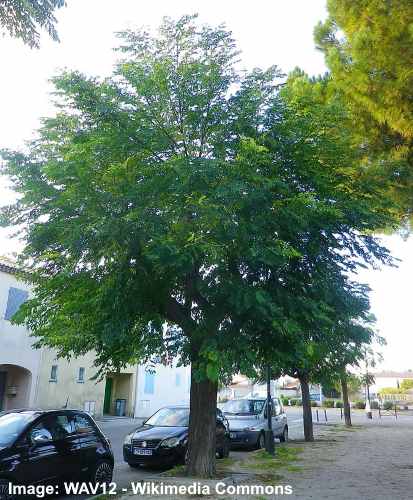
Chinaberry tree (Melia azedarach)
The chinaberry tree (Melia azedarach) is a fast-growing deciduous tree native to India, Southeast Asia, and Australia. The tree is in the flowering plant genus Melia and the family Meliaceae.
The chinaberry tree is an ornamental tree with small, fragrant purple flowers, long compound leaves, and small yellow berries. A chinaberry tree is recognizable in the landscape by its rounded open crown, brownish-red bark, and bright yellow fall color. In some warm climates, the chinaberry tree is a beautiful shade tree for a garden landscape. However, in other places, this non-native tree is invasive and can take over the landscape.
A mature chinaberry tree grows between 20 and 40 ft. (7 – 12 m) tall and wide. Although not native to the United States, chinaberry trees grow widely in USDA zones 7 through 10.
Chinaberry trees thrive in a wide range of soils. The trees grow in full sun or partial shade and thrive in alkaline or acidic soils. Once established, the non-native tree is relatively drought-tolerant and resistant to disease.
Chinaberry tree also goes by the following names: chinaberry bead tree, pride of India, China ball tree, Persian lilac, Texas umbrella tree, white cedar, or China tree.
Further reading: Chinaberry Tree (Melia azedarach) – Identification and Care.
Palo Verde Trees (Parkinsonia)
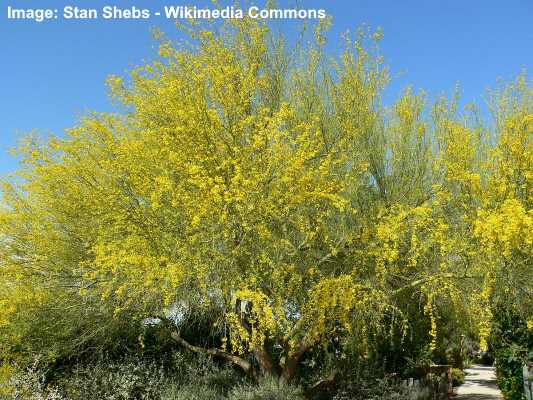
Blue palo verde tree (Parkinsonia florida) in bloom
Palo verde is a group of large flowering shrubs or small trees with green branches, yellow pea-like flowers, brown seed pods, and small leaves that appear for a short time after rainfall. This deciduous flowering desert tree is native to the hot, arid regions of California, Arizona, and Mexico. The multi-stemmed ornamental tree thrives during drought and is an excellent landscape tree for filtered shade during scorching weather.
Several species of palo verde trees are native to North America. The most common trees in the species are the foothill palo verde which is also called Mexican palo verde (Parkinsonia aculeata), blue palo verde (Parkinsonia florida), and desert museum palo verde (Parkinsonia x ‘Desert Museum’).
Palo verde trees grow between 16 and 40 ft. (5 – 12 m). Most species of palo verde trees have sharp spines or thorns growing on the branches. The exception to this is the desert museum palo verde hybrid, which is a thornless tree. Palo verde trees also have distinctive green bark that creates visual appeal.
Palo verde trees are suitable for growing outdoors in USDA zones 8 through 11.
Further reading: Palo Verde Trees – Identification Guide.
Smoke Tree (Cotinus coggygria)
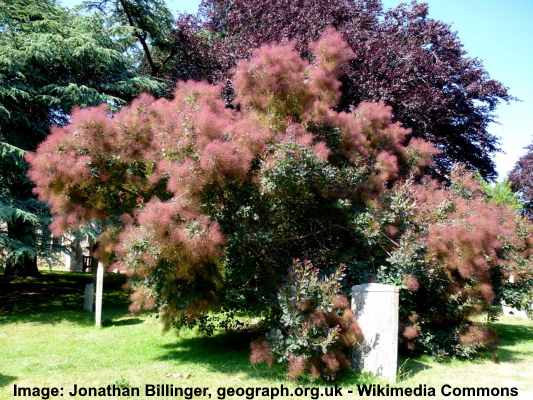
Smoke tree (Cotinus coggygria) flowers are usually vibrant pink hues, but the plumes can be in shades of red, orange, yellow, or creamy-white
The smoke tree is a stunning large shrub or small multi-stemmed tree with eye-catching purple or green foliage and feathery flower clusters resembling puffs of pink smoke. Also called smoke bush, the colorful deciduous tree creates a spectacular visual interest in a garden landscape from spring until fall.
Smoke trees grow 16 to 23 ft. (5 – 7 m) tall and have a spreading, irregular habit. The smoke tree or smoke bush is a deciduous shrub that can be trained to grow as a tree. Cotinus is a suckering shrub-like tree, so to ensure a tree shape, remove all suckers apart from the primary central stem. You should remove the stems throughout the year as they appear.
Varieties of smoke trees are cold-hardy large shrubs that thrive in USDA zones 4 through 9. Smoke trees tend to perform best in full sun to partial shade, which helps maintain their vibrant foliage.
Flowers on the smoke tree are distinctive airy plume-like panicles consisting of small five-petalled flowers. However, the fine hair-like filaments on the spent flower stems are the identifying feature of the plant, giving the smoke tree its fuzzy appearance.
The ‘Royal Purple’ smoke tree is one of the most popular Cotinus plants. The outstanding characteristics of the purple smoke tree are oval to egg-shaped deep purple leaves, clusters of tiny yellow flowers that develop into wispy plumes, and a compact growth habit. The ‘Royal Purple’ smoke tree grows 10 to 15 ft. (3 – 4.5 m) high.
Further reading: Smoke Tree – Varieties and Care Guide.
Laurel Tree (Laurus nobilis)

The laurel tree (Laurus nobilis) is a multi stemmed tree or a large shrub
Laurus nobilis is a multi stemmed evergreen tree or large shrub with aromatic, dark-green, lance-shaped leaves, clusters of pale-yellow flowers, and small black berries. Laurel leaves, or bay leaves, are commonly used to flavor many soups, stews, and sauces.
Also called sweet bay, the plant thrives in warm climates as a tree, potted shrub, or evergreen hedge. Native to the Mediterranean region, a laurel tree grows 23 – 60 ft. (7 – 18 m) tall. Due to its Mediterranean origins, a laurel tree is suitable for growing in USDA zones 8 through 10.
The best place to plant a laurel tree is in an area with full sun and free-draining soil. Sweet bay laurels thrive when they get at least six hours of sunshine daily. However, the evergreen plant will grow just as well in partial shade.
Bay laurel adapts well to many soil types. But the most important factor when planting a bay laurel tree is that the ground is well-draining.
Further reading: Laurel Tree (Sweet Bay) – Identification and Care Guide.
Sourwood Tree (Oxydendrum arboreum)

Sourwood tree in autumn
Sourwood (Oxydendrum arboreum) is a small deciduous tree in the heath family Ericaceae. Also called the sorrel tree, a unique feature of Oxydendrum arboreum is that it’s the only species in the Oxydendrum genus.
This native tree grows throughout the Eastern United States from Florida, Louisiana, and North Carolina north to Pennsylvania.
The name sourwood comes from the tree’s bitter yet edible foliage. Sourwood trees are relatively small, slow-growing, and reach 20 to 30 ft. (6 – 10 m) tall and wide.
The ornamental flowering sourwood tree is famous for its white bell-shaped flowers, green lanceolate leaves that turn deep red in the fall, and gray and reddish-brown patterned bark. Fruits on sourwood trees are small oval, egg-shaped capsules with a yellowish or greenish color that mature to a grayish-brown color.
Sourwood trees are hardy in USDA zones 5 through 9. They grow best in well-drained organically rich acidic soil and full sun.
Further reading: Sourwood Tree – Identification and Care Guide.
Hazel Trees (Corylus)
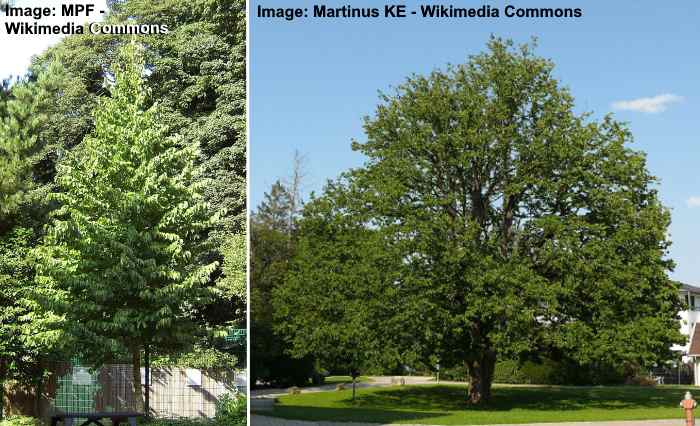
Turkish hazel (Corylus colurna) young and mature trees
Hazel is a group of large deciduous multi-stemmed shrubs or trees in the plant genus Corylus and the birch family Betulaceae that produce tasty round hazelnuts. Hazel trees and shrubs are identified by their rounded leaves with toothed margins and dangling cylindrical flower clusters called catkins.
The hardy deciduous hazel trees thrive in USDA zones 4 through 9. They perform best in full sun and moist but well-drained organically rich soil. Usually, hazel trees and shrubs produce nuts after two or three years.
While most species of hazels are multi stemmed shrubs, the Turkish Hazel (Corylus colurna) is a deciduous tree with a recognizable pyramidal crown and central trunk.
Turkish hazels are hardy in USDA zones 4 through 7 and grow throughout the United States, apart from Florida, southern Texas, and California. The hardy tree tolerates cold winters, hot summers, drought, wind, and various soil types. The Turkish hazel is a tall, majestic nut tree that grows 40 to 80 ft. (12 to 24 m) tall and has a distinct attractive conical shape.
Further reading: Hazel Trees and Shrubs – Identification Guide.
Black Tupelo Tree (Nyssa sylvatica)
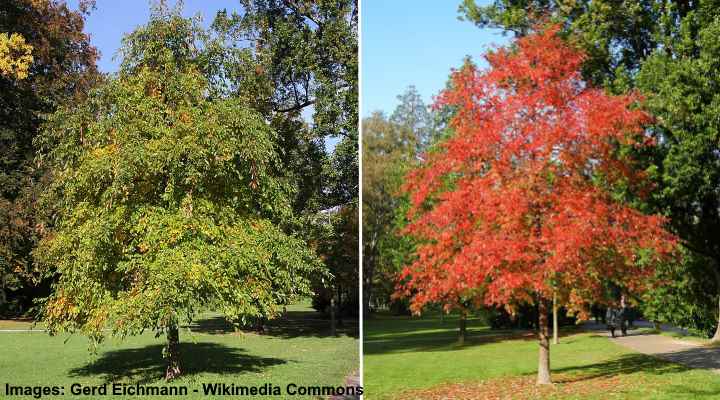
The black tupelo tree (Nyssa sylvatica) is an ornamental deciduous tree that has beautiful fall colors
The black tupelo tree is an attractive, medium-sized ornamental tree in the plant family Nyssaceae, which is native to North America. Also called the black gum or sour gum, the deciduous tree is identified by its oval, dark green glossy leaves, bark resembling alligator skin, clusters of inconspicuous greenish-white flowers, and bluish-black fruits.
One of the most spectacular features of the black tupelo tree is its eye-catching fall foliage, which can turn vibrant orange, bright red, yellow, or purple shades. The most common use for black tupelo trees is an ornamental shade or specimen tree in parks and extensive gardens.
This beautiful tree, with its conical shape, grows between 50 and 80 ft. (15 – 24 m) in ideal conditions. However, the average black tupelo’s height in residential settings is 30 to 50 ft. (10 – 15 m). It is suitable for planting in USDA zones 4 through 9. The growing conditions are full sun, evenly moist, well-drained soils, and shelter from cold winds.
The best location to plant a black tupelo tree is deep, acidic soil that stays evenly moist. Although damp ground is ideal for growing black tupelo, the tree tolerates occasional drought.
Further reading: Black Tupelo Tree: Identification and Care Guide.
Jacaranda Tree (Jacaranda mimosifolia)

Blue Jacaranda (Jacaranda mimosifolia)
The jacaranda tree is a beautiful ornamental flowering tree with spectacular clusters of intense purple-blue trumpet-shaped flowers. Also called blue jacaranda, the tree has green fern-like leaves, and a spreading umbrella-like canopy.
The jacaranda tree is native to South and Central America and is a popular flowering tree in Florida and California.
Jacaranda tree is a semi-evergreen tree that grows 25 to 50 ft. (7.5 – 15 m) tall and has a spreading rounded crown of 15 to 30 ft. (4.5 – 9 m). The tree has upright branch growth with an open habit.
Jacaranda trees are semi-tropical southern trees that thrive in USDA zones 10 and 11. You may also have success growing a blue jacaranda tree in warmer areas of growing zone 9b.
The identifying feature of the jacaranda tree is its showy lilac-blue flower clusters that bloom in the late spring or early summer. Jacaranda tree has gray-brown, finely scaly bark, brown circular seed pods, and an easily recognizable umbrella canopy covered in pinnately compound, fern-like leaves.
The best location to plant a jacaranda tree is in a place where it can get full sun. It is also vital to plant the tree at least 15 ft. (4.5 m) away from any buildings.
Katsura Tree (Cercidiphyllum japonicum)
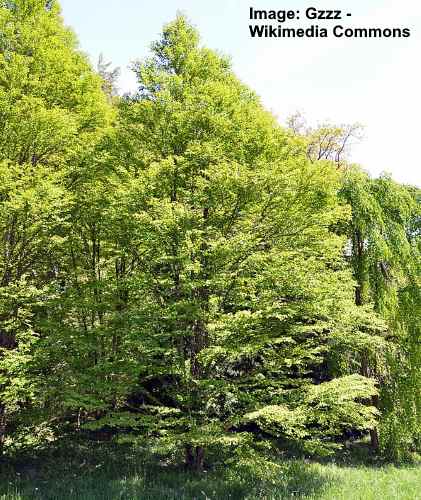
Katsura tree (Cercidiphyllum japonicum)
The katsura tree is a beautiful deciduous tree in the genus Cercidiphyllum and is native to Japan and China. Katsura trees have a medium growth rate and mature at a height of 40 to 60 ft. (12 – 18 m) tall and a trunk up to 6.5 ft. (2 m) in diameter.
The weeping katsura tree (Cercidiphyllum japonicum ‘Pendulum’) is a small to medium-sized tree with droopy branches that grows up to 20 ft. (6 m) tall and 15 ft. (4.5 m) wide.
Katsura trees have multiple stems but can be grown as single-stemmed trees and are identified by their attractive pyramidal rounded crown.
Katsura trees are also identified by their heart-shaped finely serrated dark green leaves, that turn an impressive golden-yellow color in autumn and emit a sugary, caramel aroma. The deciduous, multi-trunk tree also has recognizable grayish-brown bark that peels in thin strips and pinkish-red flower buds.
The katsura tree thrives in USDA zones 4 through 8 and performs best in full sun to partial sun in moist, well-drained soil. Some protection from the afternoon sun is preferred in hot, sunny climates.
Royal Poinciana (Delonix regia)
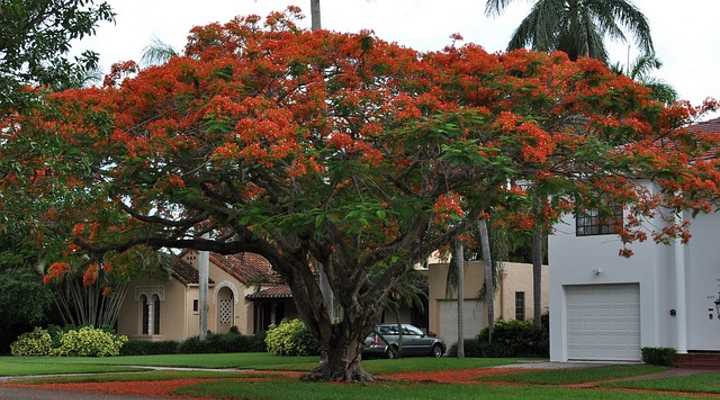
Royal Poinciana (Delonix regia)
The royal poinciana is a stunning flowering tree in the genus Delonix and pea family Fabaceae. Commonly referred to as the flame tree, it reaches heights of 30 to 40 ft. (9 – 12 m) and spans widths of 40 to 70 ft. (12 – 21 m). With its expansive canopy, the flame tree proves to be an exceptional shade tree for hot and humid climates.
Also called the flame of the forest, peacock flower tree, flamboyant tree, or flame tree, the royal poinciana is known for its masses of showy red-orange flowers in late spring and early summer, fern-like leaves and mahogany seed pods.
Royal poinciana trees thrive in USDA zones 10 through 12 and are common throughout Florida, southern Texas, Central America, and the humid regions of Mexico.
Although classified as a tropical evergreen tree, royal poinciana has deciduous foliage in areas with a mildly cool winter or dry season.
The royal poinciana tree has a fast growth rate and increases in height by about 5 ft. (1.5 m) per year. After planting, it can take a young royal poinciana tree 5 to 12 years to start flowering.
Ironwood Tree (Ostrya virginiana)
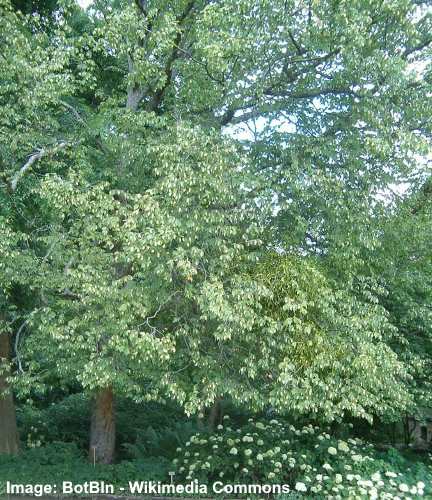
Ironwood tree (Ostrya virginiana)
The ironwood tree (Ostrya virginiana) is a small to medium sized deciduous tree identified by its light green, pointed, lance-shaped leaves with doubly-serrated margins, dangling catkins and hop-like fruits, and light to dark brown shaggy, narrow strips of bark.
The ironwood tree, also known as the American hop hornbeam, belongs to the Ostrya genus in the birch family Betulaceae. It typically reaches heights of 20 to 40 ft. (6 – 12 m) and can span widths of up to 30 ft. (9 m).
Ironwood trees grow slowly, and it will take 15 years to grow 10 to 15 ft. (3 – 4.5 m) tall. Young ironwoods have a typical pyramidal shape that gradually becomes more oval and rounded as it matures.
Ironwood trees thrive in USDA zones 3 to 9. The cold-hardy tree performs well in all growing conditions — from deep shade to full sun. As long as the soil is well-drained and not prone to flooding, ironwoods grow well in most soils.
Rowan Tree (Sorbus)
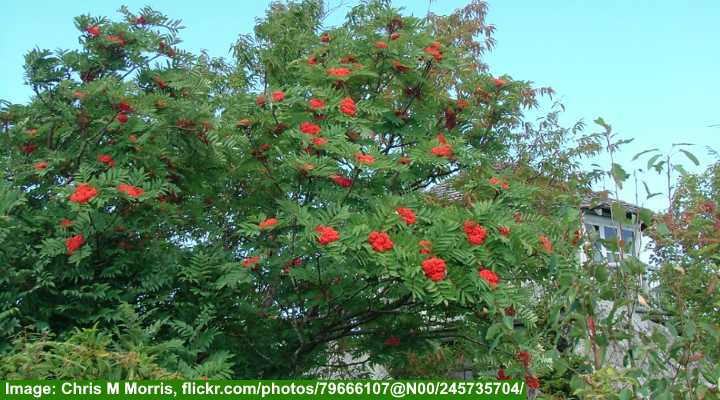
The American rowan tree (Sorbus americana) is also called the American mountain ash
The rowan tree is a small to medium ornamental flowering tree with an attractive crown consisting of pinnately compound leaves. Rowan trees are known for their showy clusters of white spring flowers followed by colorful orange or red berries appearing in the fall. Cold-hardy deciduous rowan trees are found throughout North America and Europe.
The two main species of rowan tree are the American rowan tree (Sorbus americana) and the European rowan tree (Sorbus aucuparia).
The American rowan tree grows 15 to 35 ft. (4.5 – 10 m) tall and wide. Also called the American mountain ash, this rowan species thrives in USDA zones 2 through 6. The American rowan performs best in full sun but will also tolerate some shade during the middle of the day.
The European rowan tree is a small to medium deciduous multi-stemmed tree that grows 20 to 40 ft. (6 – 12 m) tall and 8 to 25 ft. (2.4 – 7.6 m) wide.
Also called the European mountain ash, the European rowan tree performs best in USDA zones 3 through 7. However, the small decorative tree may struggle in the coldest zones unless planted in full sun.
Boxelder Tree (Acer negundo)

Boxelder tree is a deciduous multi-trunked tree which is cold hardy and tolerates poor wet soil
The boxelder (also written box elder) is a fast-growing, short-lived deciduous tree native to North America. The tree is a species of maple tree in the genus Acer and soapberry family Sapindaceae. Due to their fast growth and suckering nature, boxwoods are sometimes considered invasive or weedy.
Boxelder trees grow between 35 and 80 ft. (10 – 25 m) tall. A characteristic of boxelder trees is their multiple trunks that can form dense thickets like huge shrubs. Therefore, regular pruning is necessary to remove suckers.
Boxelders thrive in USDA zones 2 to 10, meaning they are incredibly cold-hardy. However, they are also tolerant of drought and withstand the hot sun. The medium-sized boxelder thrives in full sun or part shade and performs well in most soils.
The identifying features of a boxelder tree are its thick, multi-stemmed growth, irregular canopy, and dense foliage. In addition, this medium-sized tree has bright green, lance-shaped ovate leaves, papery winged samaras that flutter from the tree like helicopters, and small yellow-green flowers that bloom in the spring.
Floss Silk Tree (Ceiba speciosa)
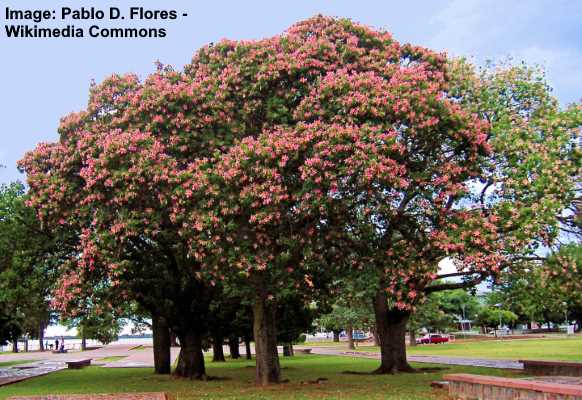
Floss Silk Tree (Ceiba speciosa)
The floss silk tree is an unusual tropical thorny tree with spiky conical prickles on its erect trunk. The floss silk tree’s horizontal branches are also covered in prickles and grow to form an attractive rounded canopy. The tree’s dark green leaves contrast with the beautiful pink hibiscus-like flowers.
The floss silk tree grows up to 82 ft. (25 m) high and it has a bottle-shaped trunk that bulges near the base. The floss tree has pink flowers, with creamy-white and yellow centers and they have five slender petals in a star shape.
The floss silk tree is easily identified by its grayish conical prickles covering the cylindrical green trunk.
Sandbox Tree (Hura crepitans)
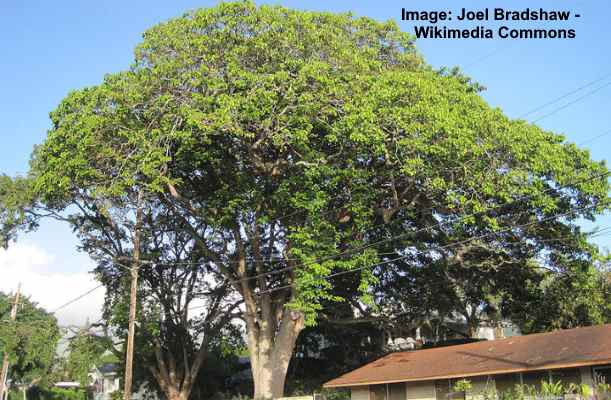
Sandbox Tree (Hura crepitans)
The sandbox tree is a spiky tree with smooth brown bark covered in extremely sharp, pyramid-shaped pointed prickles. The sandbox tree produces small red petal-less flowers, large ovate leaves up to 2 ft. (0.6 m) wide, and small roundish pumpkin-like fruits that explode when ripe.
The sandbox tree can be identified by its sharp, prickly protrusions on its trunk and its roundish pumpkin-like fruit.
The sandbox tree grows 200 ft. (60 m) tall and thrives in wet soils in USDA zones 10 and 11.
Devil’s Walking Stick Tree (Aralia spinosa)
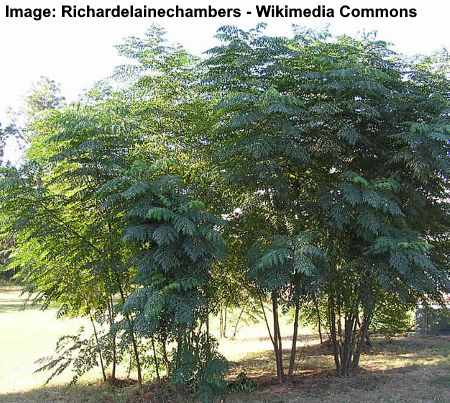
Devil’s Walking Stick (Aralia spinosa)
The devil’s walking stick is a small thorny deciduous tree with slender stems covered in sharp brown to tan spines. The spiny tree has large leaves measuring up to 45” (120 cm) long and a rounded, umbrella-shaped crown. The tree blooms in late summer with small, creamy-white flowers that develop into purplish-black berries.
With its spiny stems, the devil’s walking stick grows up to 26 ft. (8 m) tall.
The devil’s walking stick tree can be identified by its huge tropical leaves and stems with stout, sharp spines.
Kapok (Ceiba pentandra)
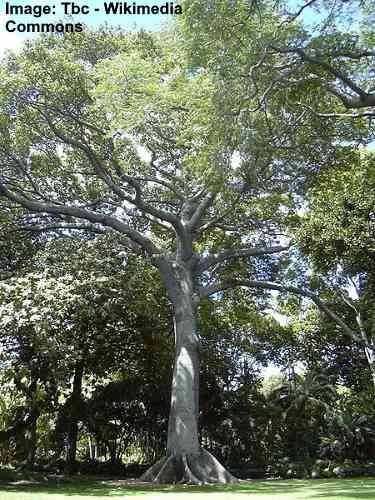
Kapok tree (Ceiba pentandra)
Kapok is a species of large tree with sharp thorns growing extensively on its bark. Kapok trees have thorny buttress roots, large palmate leaves, and clusters of tiny yellowish-white flowers. The unique characteristic of the tree is its cotton-like downy substance surrounding the seed pods.
Kapok trees are giant tropical trees that thrive in USDA zones 10 to 12. The thorny trees can grow 75 to 125 ft. (22 – 38 m) tall and up to 75 ft. (22 m) wide.
The thorny kapok tree is identified by its straight trunk covered in stout, sharp thorns, palmate compound leaves, and creamy-white flower clusters consisting of bell-shaped flowers.
Chittamwood Tree (Sideroxylon lanuginosum)

Chittamwood Tree (Sideroxylon lanuginosum)
The Chittamwood tree is a small, shrub-like tree with thorny branches. The deciduous Chittamwood tree can be identified by its spiny, stiff, woolly branches, oblong green leaves with fuzzy undersides, and clusters of purplish-black fruits. The multi-stemmed Chittamwood tree grows up to 40 ft. (12 m) tall and has a straight trunk and rounded, narrow crown.
Other common names of the Chittamwood tree include wooly buckthorn, gum bumelia, and gum bully.
Osage Orange (Maclura pomifera)
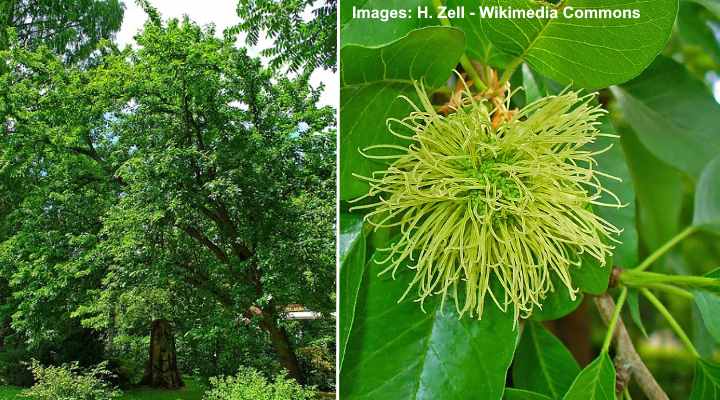
Osage Orange (Maclura pomifera)
The osage orange tree is a mid-sized, multi-stemmed tree with sharp thorns on its interlacing branches. This thorny deciduous tree has a rounded crown of shiny, dark green leaves and small greenish spring flowers. Due to the nasty thorns on the small shrub-like tree, the tree can be used as a security hedge or living fence.
The identifying feature of the osage orange tree is its large orange-like round yellowish-green fruits. The unusual round, inedible fruits are about the size of a baseball.
Osage orange trees grow 25 to 60 ft. (7.5 – 18 m) tall. The osage orange tree thrives in USDA zones 4 to 9.
Podocarpus Trees (Podocarpus macrophyllus and Podocarpus gracilior)
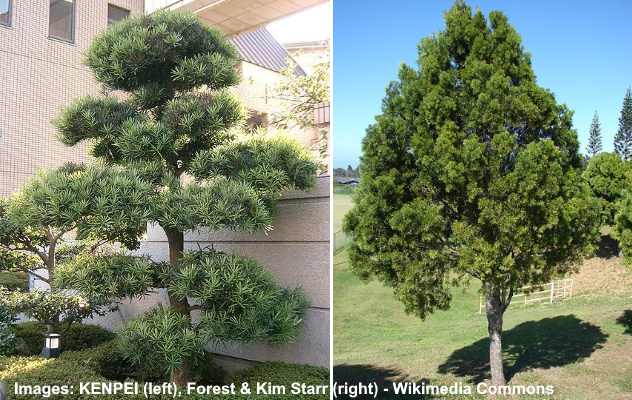
Podocarpus trees: Podocarpus macrophyllus (left) and Podocarpus gracilior (right)
Podocarpus trees are types of conifers in the family Podocarpaceae with dense evergreen foliage.
Podocarpus macrophyllus is a slow-growing small to medium-sized evergreen tree which has upright, pyramidal growth and grows to between 20 and 40 ft. (6 – 12 m) high.
Podocarpus macrophyllus trees thrive in rich, slightly acidic soil that has excellent drainage. They don’t need much watering and are relatively drought-resistant. Podocarpus macrophyllus trees thrive in zones 7 – 9.
The species Podocarpus macrophyllus also goes by the names fern pine, yew plum pine, and Buddhist pine. Although the Podocarpus plant is commonly called the Japanese yew, it’s not a true member of the Taxaceae family, which the yew belongs to.
Another type of podocarpus tree is Podocarpus gracilior which is a medium-sized evergreen conifer with a pyramidal shape. Also called weeping podocarpus trees or African fern trees, the tree has soft, dense evergreen foliage. The slow-growing shade tree grows up to 40 ft. (12 m) high. Podocarpus weeping trees thrive in zones 9 – 11.
Manzanita Tree (Arctostaphylos)
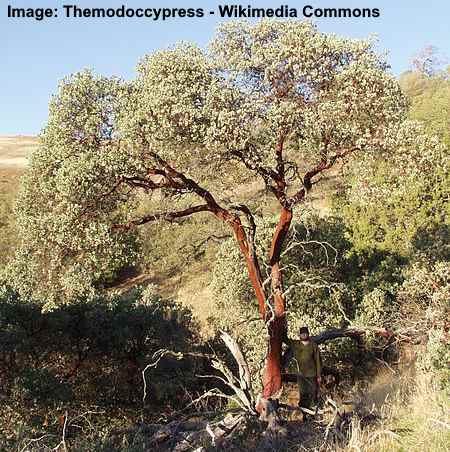
Big berry manzanita (Arctostaphylos glauca)
Manzanita trees are a group of small trees with shrubby growth belonging to the flowering plant genus Arctostaphylos.
The trees are native to the western coast of the United States and grow in USDA zones 8 through 10. There are around 60 species of manzanita trees, all of which have evergreen foliage apart from one.
Manzanita trees are attractive flowering plants with eye-catching red bark. The small ornamental trees bloom with bell-shaped pale pink or white flowers. The manzanita flowers are followed by small edible berries. However, the most attractive feature of the evergreen small trees is the distinctive reddish-brown or mahogany bark covering twisted, gnarled branches.
The largest species of manzanita trees, like the big berry manzanita (Arctostaphylos glauca), grow as tall as 20 ft. (6 m).
Manzanitas are valuable trees for dry landscapes because they are suitable for growing in various soil types and tolerate full sun and drought.
Pink Shower Tree (Cassia grandis)
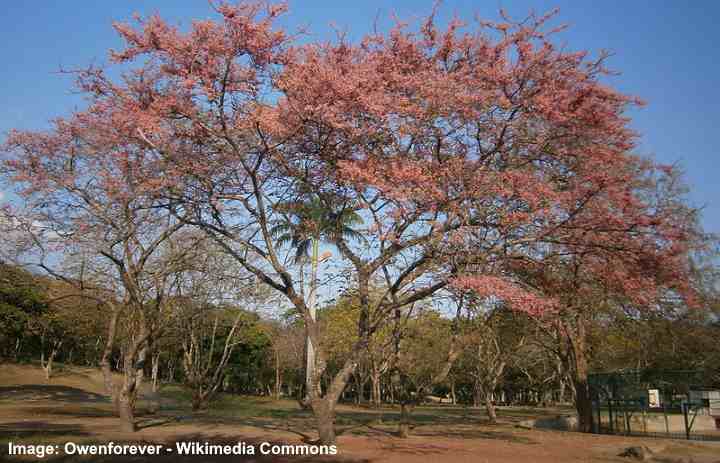
The pink shower tree is an attractive, deciduous tree with a broad, spreading canopy. This spring-blooming tree is known for its clusters of stunning pink flowers with prominent, hook-like yellow stamens. The pink flowers beautifully contrast against the lush green canopy of pinnate, feather-like leaves. The tree also features cylindrical, elongated seed pods that are dark brown in color.
Native to Asia, the pink shower tree is often planted as an ornamental feature in outdoor areas such as parks due to its beauty. With its wide canopy, the pink shower tree is also an excellent option for providing shade. Once the flowering season ends, a pink carpet of flowers forms below the tree, creating a beautiful sight.
The pink shower tree can grow to be 40 to 60 feet (12 – 18 meters) tall and wide. It thrives in USDA zones 10 to 12 in either full or partial sun.
Japanese Snowbell (Styrax japonicus)
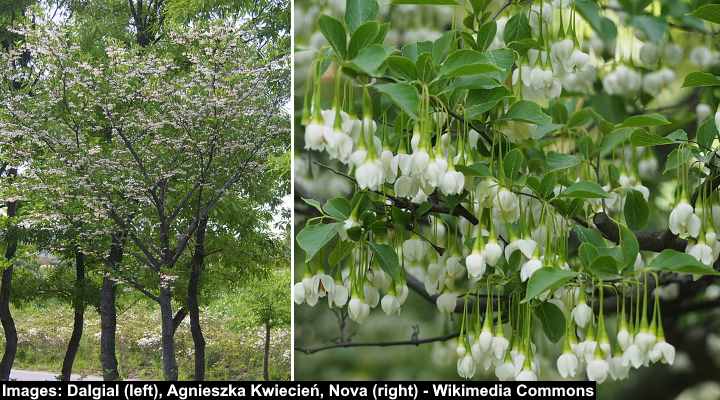
The Japanese snowbell is a small flowering tree that thrives in tropical climates. It is characterized by its pendulous, bell-shaped, creamy-white flowers. These attractive flowers have prominent yellow stamens and release a delightful floral scent. As fall approaches, the tree’s oval-shaped deep green leaves shift into delightful hues of yellow or orange, adding beauty to the autumn landscape.
Other than its beautiful white flowers, the Japanese snowbell also features attractive bark that peels off to reveal a smooth trunk with a cinnamon-like color. This white-flowering tree also has small, greenish-gray egg-shaped fruits that appear in August and September.
For optimal growth, plant the Japanese snowbell in acidic, well-drained soils that are rich in organic material. When shielded from chilly winds, these graceful trees thrive in woodland gardens, containers, and as captivating centerpieces or specimen trees. In addition, they don’t require much maintenance and usually stay clear of significant pest or disease issues.
The Japanese snowbell can reach a height and width of up to 20 to 30 ft. (6 – 9 m) and thrives in USDA zones 6 to 8. Make sure to plant this tree in partial shade for optimal growth.
Japanese Lilac Tree (Syringa reticulata)
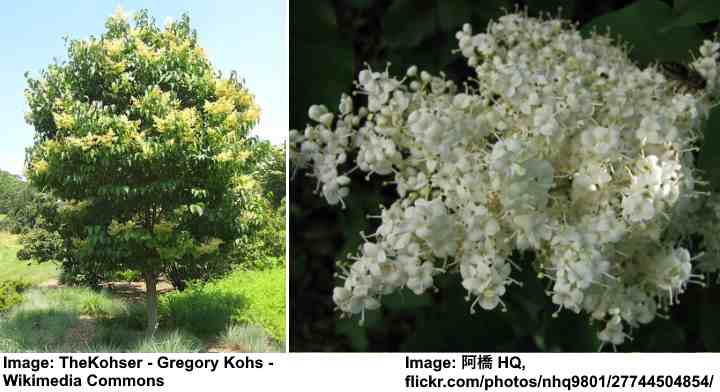
The Japanese lilac is a small- to medium-sized deciduous tree known for its abundant clusters of small, creamy-white flowers. Some identifying features of the Japanese lilac are its peeling, reddish-brown bark and dark green, drooping leaves with pointy tips. The tree’s fragrant white flowers bloom during early summer, creating a beautiful floral display.
Japanese lilac trees grow well in various soil types, such as clay and sandy soils, as long as they are well-drained. These small flowering trees serve as wonderful options for foundation plantings, specimen trees, standalone focal points, or enhancing the beauty of any landscape.
Japanese lilacs are low-maintenance and ideal for garden landscapes in cooler climates. Their small size, lush foliage, and appealing blooms make them popular ornamental trees.
The Japanese lilac can reach a height of 20 to 30 ft. (6 – 9 m) and a spread of 15 to 25 ft. (4.5 – 7.5 m). They grow best in USDA zones 3 to 7 in full sun to partial shade.
American Yellowwood (Cladrastis kentukea)
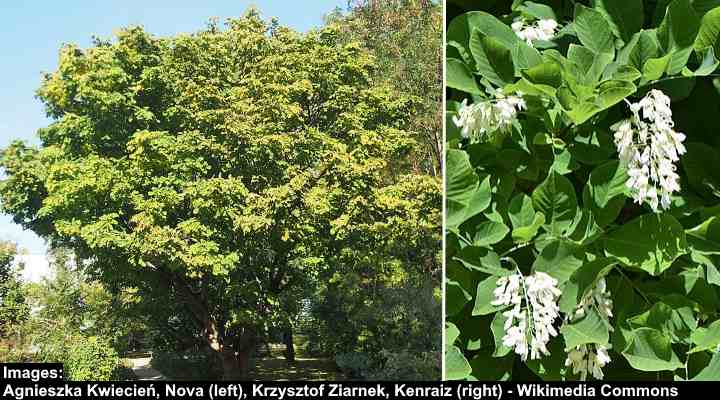
The American yellowwood is a medium-sized deciduous tree native to the southeastern United States. This tree is known for its drooping clusters of fragrant white flowers, bright green, feather-like compound leaves, and tan seed pods. During the fall, the leaves transition into bright yellow and orange hues.
Other identifying features of the American yellowwood are its smooth gray bark and rounded canopy. For optimal growth, plant the American yellowwood tree in moist, well-drained soil in full sun.
American yellowwoods are good selections as lawn trees, placed near patios and decks, or used as shade providers in medium to large backyards.
American yellowwoods usually reach heights of 30 to 50 ft. (9 – 15 m) with a spread of 40 to 55 ft. (12 – 15 m). Grow these trees in USDA zones 4 to 8.
Purple Glory Tree (Tibouchina granulosa)
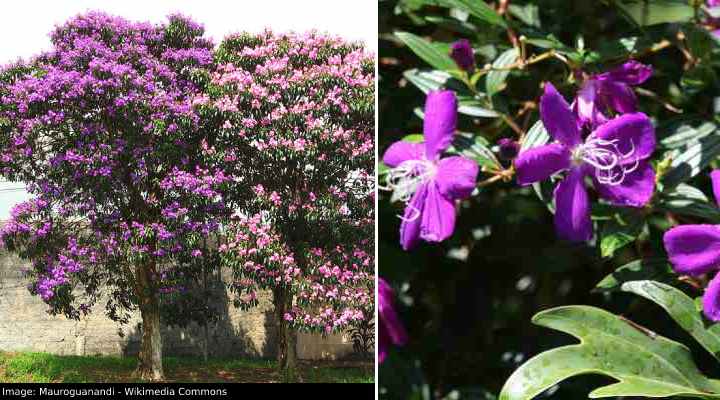
The purple glory tree is a small, evergreen tree with lush foliage and a rounded canopy. The tree enhances the beauty of any landscape with its stunning violet-purple flowers. The tree’s flowers bloom throughout the year, covering the canopy with a stunning display of purple blossoms. The large, velvety flowers beautifully contrast against the dark green, glossy lanceolate leaves.
The purple glory tree grows best in hot, tropical climates such as South Florida. The tree thrives in soil that is moist, well-drained, and rich in organic material. Make sure to plant this tree in the shade in hotter climates.
The purple glory tree’s versatility allows it to serve as an accent tree, specimen tree, or individual focal point. Its beautiful flowers and round canopy make it a popular ornamental tree, often planted in parks or streets.
The purple glory tree can reach a height and width of 15 to 20 ft. (4.5 – 6 m). Plant this tree in USDA zones 10 or 11 in full sun to partial shade.
Purple Robe Locust Tree (Robinia pseudoacacia ‘Purple Robe’)
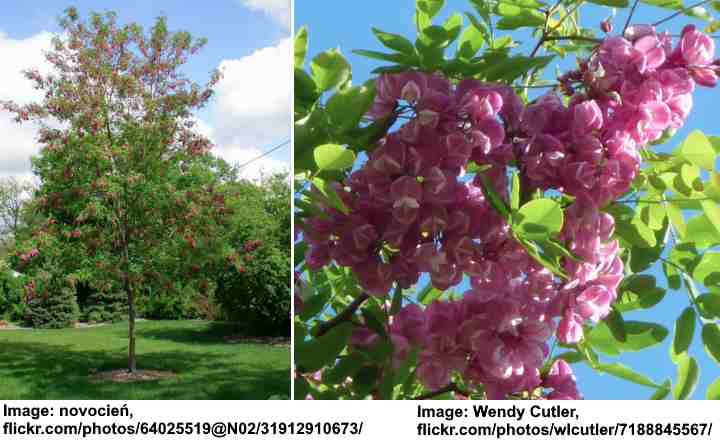
The ‘Purple Robe’ locust tree is a beautiful ornamental tree with short spines on its branches and stems. The tree is known for its hanging clusters of fragrant, pea-like pink-purple flowers. In late spring, the wisteria-like flowers cover the canopy. After the blooming period, the tree grows elongated, flattened, bean-like seed pods.
The ‘Purple Robe’ locust tree’s leaves emerge reddish-bronze and mature into a beautiful blue-green color. The lance-shaped leaflets of the pinnate leaves provide an attractive backdrop against the light purple blooms. With the onset of autumn, the leaves adopt a muted yellow hue.
The ‘Purple Robe’ locust tree is fast-growing and resilient, tolerating different soil conditions. The tree serves as a great shade tree or specimen tree in medium-sized gardens. Additionally, the lively purple blooms attract bees and butterflies, adding to the tree’s charm.
The ‘Purple Robe’ locust tree ranges from 30 to 40 ft. (9 – 12 m) in height and 20 to 30 ft. (6 – 9 m) in width. Grow in full sun to light shade in USDA zones 4 to 8.
Empress Tree (Paulownia tomentosa)

The empress tree is a deciduous, fast-growing tree with an umbrella-shaped crown and a broad canopy. It is known for its beautiful tube-shaped, violet-purple flowers that emit a delightful fragrance. The tree begins blooming in the spring season. It is also recognized for its extremely large, heart-shaped leaves that can reach 6 – 16 inches (15 – 40 cm) long. Before these leaves emerge, the funnel-shaped flowers cover the tree’s bare branches, creating a captivating display.
The empress tree’s leaves have a thin layer of hair on both sides. Its lush and expansive canopy provides shade during summer. During autumn, the leaves turn a yellow color before eventually falling. In addition, the tree also features long, woody seed capsules that contain small helicopter seeds.
The empress tree is a popular tree for decorative uses due to its fast growth rate, unique leaves, and sweet-smelling flowers. Planting options include using it as a standalone specimen tree, arranging it in groups, or using it as a hedge that resembles a shrub. The tree tolerates many different soil types but prefers well-drained, fertile soils.
Although it is beautiful, it is worth noting that the empress tree can become invasive in parts of North America and Europe.
The empress tree can reach a height and width of 40 to 60 ft. (12 – 18 m). Grow in full sun in USDA zones 5 to 9.
Red Silk Cotton Tree (Bombax ceiba)
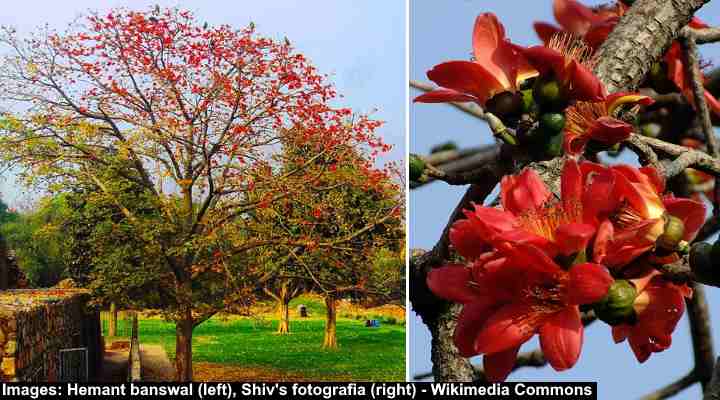
The red silk cotton tree is a deciduous, red-flowering tree that grows best in warm tropical and subtropical climates. The tree is known for its beautiful red flowers and capsule-like seed pods that contain fibrous white cotton. The trunk is smooth and gray-colored, and it may also contain spikes when the tree is young. This heat-loving tree adds tropical charm to landscapes. The leaves are palmate and bright green in color.
The red silk cotton tree is frequently grown in warm, subtropical regions such as Florida and southeast Asia. In addition, it is a popular shade tree in large, open spaces and parks.
The red silk cotton tree is 60 to 70 ft. (18 – 21 m) tall and 40 to 60 ft. (12 – 18 m) wide. It thrives in USDA zones 10 to 12 in full sun.
African Tuliptree (Spathodea campanulata)
The African tuliptree is a medium-sized evergreen tree with a spreading canopy of deep green, glossy leaves. The lush green canopy provides a stunning backdrop against its reddish-orange bell-shaped flowers. Other identifying features of this tree are its gray-brown bark and flattened, brown seed pods.
The African tuliptree’s beautiful, tulip-like flowers, lush foliage, and distinctive bark make it a popular choice as an ornamental tree. It is often grown in gardens, city parks, and along streets. The tree’s spreading canopy also makes it a good choice as a shade tree.
The African tuliptree grows best in moderately fertile, well-drained soil in full sun. It usually reaches a height of 25 to 40 ft. (7.6 – 12 m) and a width of 15 to 20 ft. (4.5 – 6 m). Plant in USDA zones 10 to 11.
Red Silky Oak Tree (Alloxylon flammeum)

The red silky oak tree is a medium-sized, eye-catching tree with elliptical, glossy green leaves and attractive light-gray bark with lenticels. It is recognized for its beautiful red flowers, which resemble traditional waratah blooms. The flowers point upward and grow in clusters, adding a touch of beauty to the surrounding landscape. In autumn, the tree grows woody seed pods that sit on long stalks.
The red silky oak tree flourishes as a standout tree in expansive gardens, parks, and open areas. The tree is also often grown as a shade tree due to its spreading canopy and dense foliage.
The red silky oak tree can reach 30 to 50 ft. (9 – 15 m) tall and 20 to 30 ft. (6 – 9 m) wide. Grow in USDA zones 9 to 11 in full sun to partial shade.
Indian Coral Tree (Erythrina variegata)
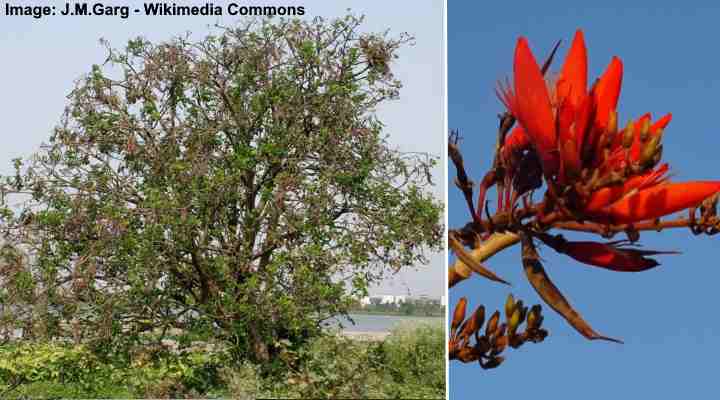
The Indian coral tree is an attractive deciduous tree with compound, clover-like leaves. The leaves are usually light green or green in color and may display variegated or mottled patterns, adding to the tree’s charm. It is also recognized for its beautiful crimson or scarlet flowers that grow in clusters at the branch tips. These flower clusters resemble coral, giving the tree its name. The blooms are followed by elongated, red or brown seed pods that contain poisonous black seeds.
The Indian coral tree’s lush foliage and spreading canopy make it a popular shade tree. It tolerates a wide range of soil conditions, although it thrives in well-drained soil. The tree is often planted in larger gardens, parks, and open areas. Its beautiful flowers add a vibrant touch to any landscape.
The Indian coral tree grows between 20 to 40 ft. (6 – 12 m) tall and wide. Plant in full sun in USDA zones 10 or 11.
Flame of the Forest Tree (Butea monosperma)
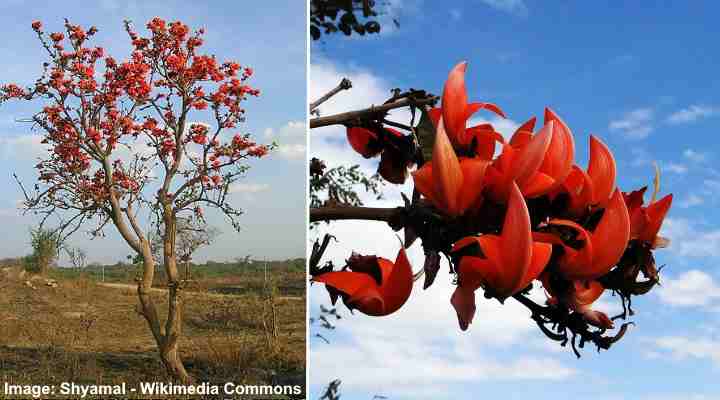
The flame of the forest is a small to medium-sized deciduous tree known for its distinctive, hook-like flowers that are vibrant red-orange in color. In late winter or early spring, the tree’s wide, expansive canopy is covered with stunning red blossoms. After the flowers fade, the tree showcases flat, single-seeded bronze-brown pods.
The leaves of the flame of the forest are compound and trifoliate, growing alternately on the stems. The tree’s graceful form and bright flowers are sure to enhance the appearance of any garden.
Flame of the forest trees are popular shade trees in parks and medium-sized gardens. They tolerate a range of soil conditions, though they prefer well-draining, organically rich, fertile soils. Additionally, they are tolerant of both drought and flooding conditions.
The flame of the forest tree can reach a height and width of 30 to 40 ft. (9 – 12 m). It grows in USDA zones 10 to 12 in full sun to partial shade.
Firewheel Tree (Stenocarpus sinuatus)
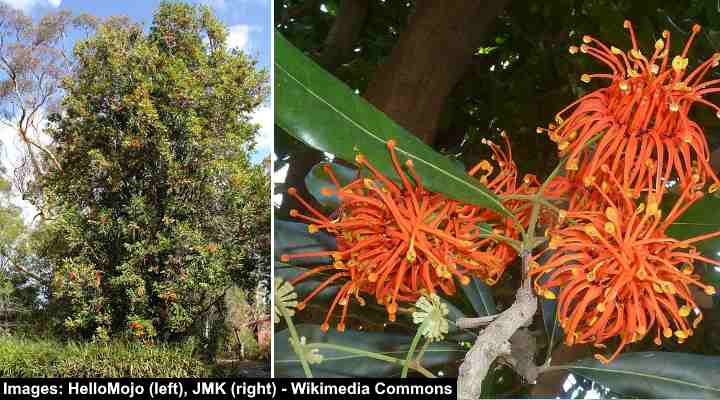
The firewheel tree is an eye-catching, evergreen tree that grows in sunny tropical and subtropical climates. This red-flowering tree is known for its large circular flower clusters that resemble a fiery wheel, giving the tree its name. The flowers bloom in summer and range in color from deep scarlet to bright crimson. Another identifying feature of the firewheel tree is its leathery, dark green leaves which contrast nicely with the bright red blooms.
The ornamental firewheel tree is low-maintenance and adapts to various soil types, though it prefers well-drained soil. It is an excellent choice for adding a touch of vibrant red hues to your garden.
The firewheel tree reaches a mature size of 30 to 50 ft. (6 – 9 m) tall and 20 to 25 ft. (6 – 10 m) wide. The tree thrives in USDA zones 9 to 11 in full sun to partial shade.
Flame Tree (Brachychiton acerifolius)
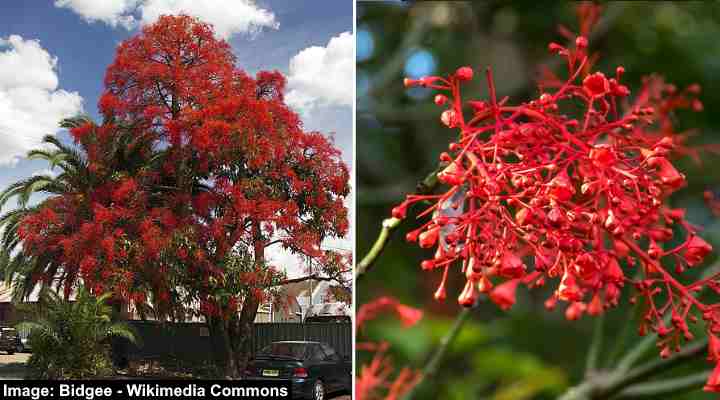
The flame tree is a medium-sized, deciduous tree with a spreading crown. The tree produces abundant clusters of vibrant red or scarlet, bell-shaped flowers with a star-like form. Its pyramidal canopy is covered with beautiful red flowers in spring and summer, adding beauty to the surrounding landscape.
The flame tree can be recognized by its glossy, maple-like leaves that are dark green in color. These five-lobed leaves will transition into a vibrant yellow hue in the fall before dropping, revealing the tree’s distinctive branching structure. The tree also produces woody, brown seed pods that contain yellow, hairy seeds.
Flame trees are popular for their beautiful flowers, unique canopy shape, and dense foliage. They are often grown in medium-sized outdoor spaces, gardens, and parks. These trees can be used in landscapes as shade providers, focal points, or distinctive individual specimens. Their presence is sure to add a touch of elegance and beauty to any outdoor area.
The flame tree can reach a height of up to 30 to 50 ft. (9 – 15 m) and a width of 25 to 40 ft. (7 – 12 m). Plant this tree in USDA zones 9 to 11 in full sun or partial shade.
Southern Silky Oak Tree (Grevillea robusta)
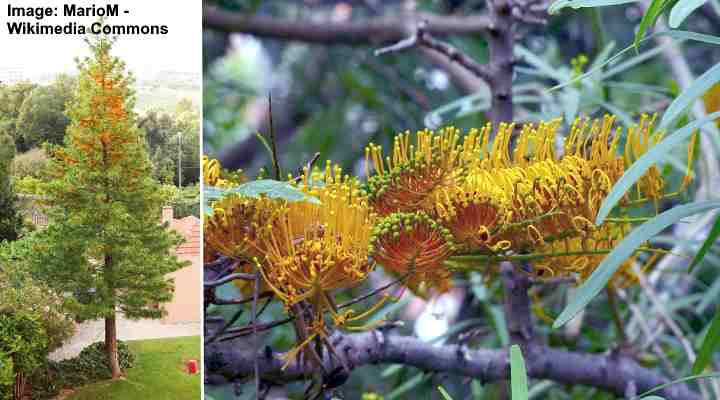
The southern silky oak is a fast-growing evergreen tree with an upright growth pattern. The tree displays beautiful yellowish-orange or reddish flowers with protruding, yellow-tipped, orange stamens. In spring and summer, the flowers bloom in colorful clusters. The tree can also be identified by its pinnately compound, fern-like leaves that have a pale-green hue.
The southern silky oak has a pyramidal canopy when it is young. Its attractive shape makes it an excellent addition for larger landscapes such as city parks or public gardens. It can also be grown as a specimen plant, a focal point, or even in xeriscape gardens.
The southern silky oak grows best in well-drained, moist soil with a sandy or loamy texture. The tree is hardy and is capable of enduring drought conditions. Ensure that the tree is planted in full sun, as it loves the heat of southern California, Texas, and Florida.
The southern silky oak can reach a height of 40 to 70 ft. (18 – 21 m) and is suitable for growing in USDA zones 9 to 11.
Geiger Tree (Cordia sebestena)
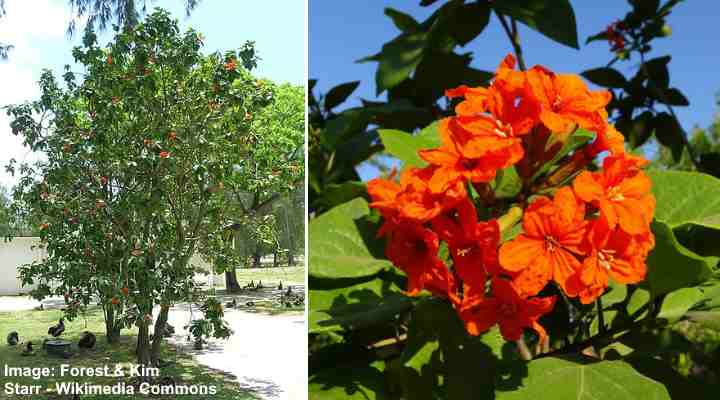
The Geiger tree is a small, evergreen tree native to the Florida Keys. The tree is known for its vibrant orange-red, funnel-shaped flowers and alternate, heart-shaped leaves. The flowers bloom during summer and fall, growing in clusters at the ends of the branches. Some other identifying features of this tree are its irregular branching pattern, year-round blooming, and pear-shaped, fragrant white fruits.
The Geiger tree thrives in warm, tropical climates. It can be grown as a specimen tree, along city streets, or as an accent alongside larger trees. The tree’s compact size makes it especially suitable for smaller garden landscapes.
Geiger trees are tolerant of salt spray and brackish water, making them a perfect addition for planting in coastal regions such as beaches or seaside gardens. The tree is low-maintenance and grows best in various soil types, as long as they are well-drained. Make sure to keep this tree away from frost.
The Geiger tree can reach a height of 10 to 30 ft. (4.5 – 7.6 m) and a width of up to 15 ft. (4.5 m). It is suitable for growing in USDA zones 10 to 11. Plant the tree in full sun, light shade, or dappled sunlight.
Australian Christmas Tree (Nuytsia floribunda)
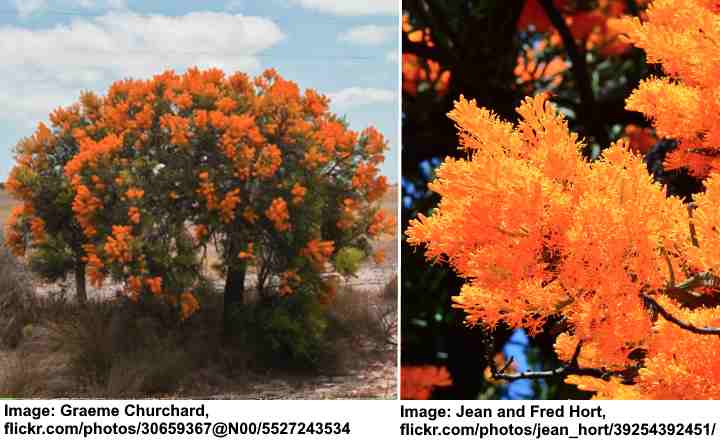
The Australian Christmas tree is a medium-sized tree recognized for its beautiful display of vivid orange blooms that are long and tubular in shape. The tree gets its name from the fact that its blooming coincides with the Christmas season of the Southern Hemisphere. Additionally, the tree produces small, papery seed cases, ranging in hues from gray-green to bluish-green, and yellowish.
The Australian Christmas tree is hardy, capable of withstanding various soil types, such as sandy, gravelly, and drought-prone soils. Its attractive flowers and compact growth habit make it a popular choice for medium-sized landscapes.
It is important to remember that the Australian Christmas tree obtains its water and nutrients by attaching to the roots of small plants. This behavior has the potential to cause damage to surrounding plants and electrical cables.
The Australian Christmas tree grows up to 33 ft. (10 m) tall. Grow this tree in USDA zones 9 to 11 in full sun or partial shade.
Golden Wonder Tree (Senna spectabilis)

The golden wonder tree is a small ornamental tree known for its bright yellow flower clusters that cover the tree’s canopy, presenting a stunning floral display. The tree blooms during summer, with its flower clusters growing up to 20 inches (50 cm) in length. In addition, it showcases pinnately compound, evergreen leaves up to 3 inches (7.5 cm) in size. The leaves range in color from green to yellow.
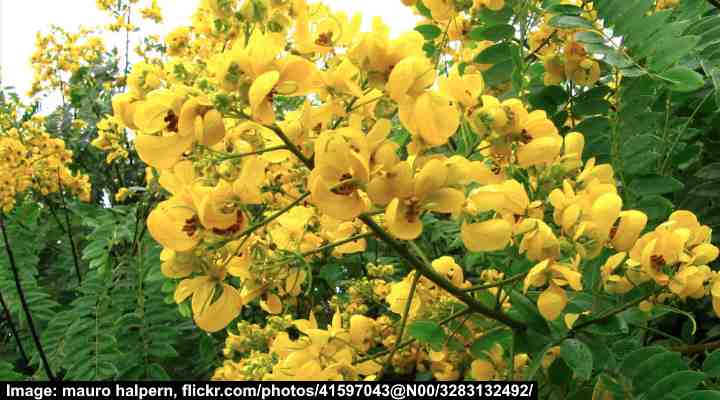
Senna spectabilis flowers
The golden wonder tree’s appealing golden yellow blooms make it a favored ornamental choice in small- to medium-sized gardens. The tree’s spreading canopy makes it a good shade provider in southern backyards. This fast-growing tree is capable of withstanding drought and heat. It also flourishes in various soil types, as long as they are well-drained. If you have a tropical garden, consider adding the golden wonder tree for its ornamental beauty and compact size.
The golden wonder tree can grow to be 15 to 20 ft. (4.5 – 6 m) tall and wide. Plant in USDA zones 9 to 11 in full sun.
Sweet Acacia (Vachellia farnesiana)
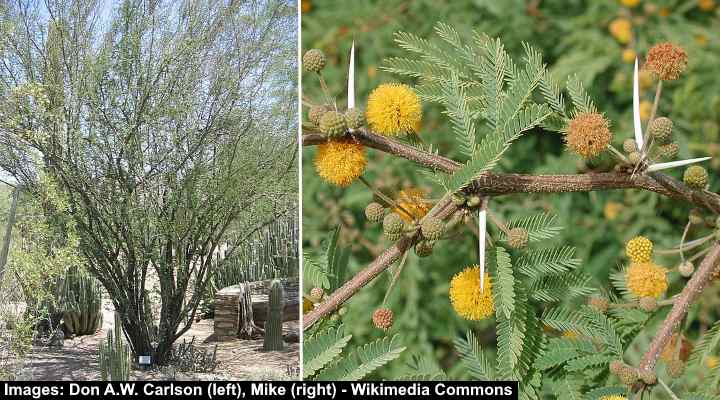
The sweet acacia tree is a semi-evergreen, small tree with a broad, vase-shaped canopy. It is popular for its beautiful clusters of highly-fragrant, pom-pom-like yellow-golden flowers. The flowers attract the attention of bees, butterflies, and other pollinators during late winter and spring. The tree showcases feathery, fern-like leaves, adding an ornamental touch.
The sweet acacia tree flourishes in moist, well-drained soils. It is tolerant of drought and salt once established, making it suitable for planting in coastal areas. In addition, the tree’s thorn-covered branches and evergreen foliage create a great security screen or privacy hedge.
The sweet acacia tree can reach up to 15 to 20 ft. (4.5 – 6 m) tall and wide. Grow in USDA zones 9 to 11 in full sun to partial shade.
Yellow Silk Cotton Tree (Cochlospermum religiosum)

The yellow silk cotton tree is an exquisite tropical tree with deep green, palmate leaves. It is known for its stunning display of buttercup-like, bright yellow flowers that can reach up to 4 inches (10 cm) wide. The tree’s large, showy flowers create a stunning display, adding beauty to the surrounding spring and summer landscape. The tree also produces distinctive black seeds covered in white, wooly hairs.
Also known as the buttercup tree, the yellow silk cotton tree makes an excellent accent plant or ornamental tree in medium-sized landscapes. It is also popular as a shade tree due to its wide, spreading canopy. With its attractive ornamental features, this tree is sure to add a touch of beauty to tropical and subtropical gardens.
The yellow silk cotton tree can reach up to 25 ft. (7.5 m). Grow in USDA zones 9 to 11 in full sun.
Willow Pittosporum (Pittosporum phillyreoides)
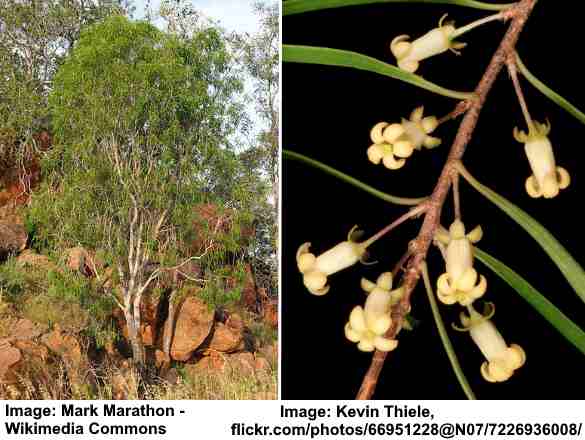
The willow pittosporum is a slow-growing, evergreen tree with multiple trunks. It is known for its clusters of small, creamy yellow flowers. This compact tree has a graceful weeping habit, adding to its charm. Its beauty is enhanced further by its glossy green, narrow leaves and orange, ball-shaped fruits.
Willow pittosporum trees are versatile, making them well-suited for various planting purposes such as being utilized as lawn trees, accent trees, and even as distinctive specimen plants within xeriscapes. Their upright, drooping growth pattern makes them perfectly suitable for small gardens or tight spaces. The flowers are also very fragrant, attracting pollinators such as bees and butterflies.
The willow pittosporum can reach 20 to 30 ft. (3 – 9 m) tall and wide. It thrives in USDA zones 7 to 11 in full sun.
Verawood (Bulnesia arborea)
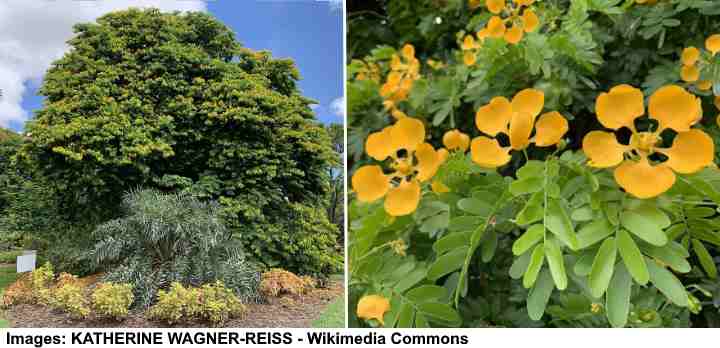
The verawood tree is a flowering, evergreen tree with olive-green, fern-like leaves. The tree is highly valued for its exquisite, five-petaled yellow flowers with spoon-like petals. The yellow flowers appear in small clusters, beautifully contrasting against the lush green foliage. Over time, the tree develops a graceful, umbrella-like canopy, adding to its decorative appeal.
The verawood tree proves to be a great option for small- to medium-sized landscapes. This hardy, slow-growing tree flowers for an impressive two to three months, adding beauty to the surrounding landscape. The tree can tolerate poor soil conditions, though it prefers well-drained soil. Make sure to properly prune the tree during its early growing stages to ensure an attractive upper canopy.
The verawood tree reaches 20 to 30 ft. (6 – 10 m) tall and wide. The tree thrives in USDA zones 10 to 12 in full sun.
Tipu Tree (Tipuana tipu)
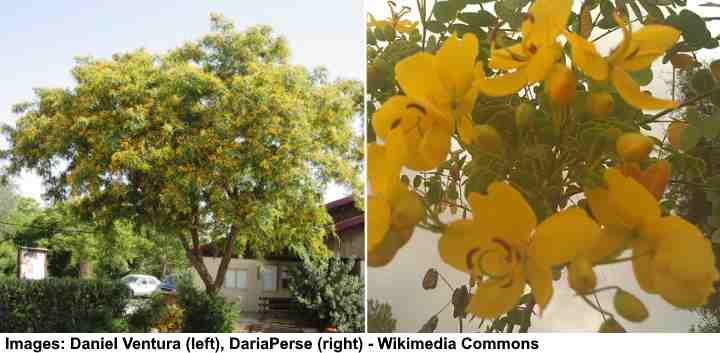
The tipu tree is an attractive deciduous tree with a vast, spreading canopy. It has large, pinnately compound leaves that can measure up to 10 inches (25 cm) in length. The tree is covered with attractive clusters of bright yellow, trumpet-like flowers. Blooming from spring through fall, the yellow flowers beautifully contrast against the lush green foliage. In the autumn months, the tipu tree sheds its leaves and produces numerous winged seed pods known as samaras.
Also known as the pride of Bolivia or rosewood, the tipu tree is sure to enhance the beauty of your garden landscape. This ornamental tree is versatile, capable of being used as a stunning focal point in larger, open areas such as parks. In addition, the tree’s spreading canopy makes it an ideal choice for providing shade.
The tipu tree is drought-tolerant and can withstand hot and dry conditions, making it suitable for planting in xeriscapes or desert landscapes.
The tipu tree can reach a height of up to 50 ft. (15 m) tall. It grows well in USDA zones 9 to 11 in full sunlight.
Scholar Tree (Sophora japonica)
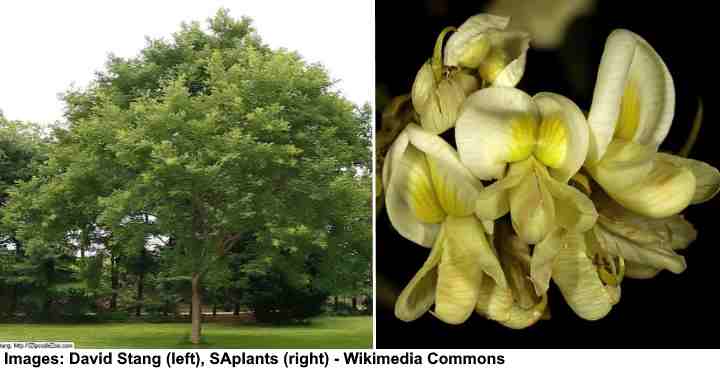
The scholar tree, also known as the Japanese pagoda tree, is a popular ornamental tree. It is valued as a shade tree due to its large, rounded canopy. The tree is known for its attractive clusters of greenish-white or yellow flowers. The tree blooms in midsummer, with the flowers persisting for several weeks. During autumn, the tree produces decorative seed pods, and the leaves turn a lovely shade of golden yellow.
Scholar trees are versatile, capable of being grown in various soil types, including clay, loam, and sandy soils, as long as they are well-drained. The tree is renowned for offering both shade and visual allure to landscapes. It is also recognized for its resilience against drought and resistance to salt spray, making it a fitting choice for planting in coastal settings.
Specific scholar tree cultivars, such as the weeping ‘Pendula’ scholar tree, are more suitable for those with compact or smaller yards due to their narrow, upright habit.
The scholar tree can reach 40 to 60 ft. (12 – 18 m) tall and 30 to 50 ft. (9 – 15 m) wide. It is suitable for planting in USDA zones 5 to 8 in full sun to partial shade.
Golden Rain Tree (Koelreuteria paniculata)
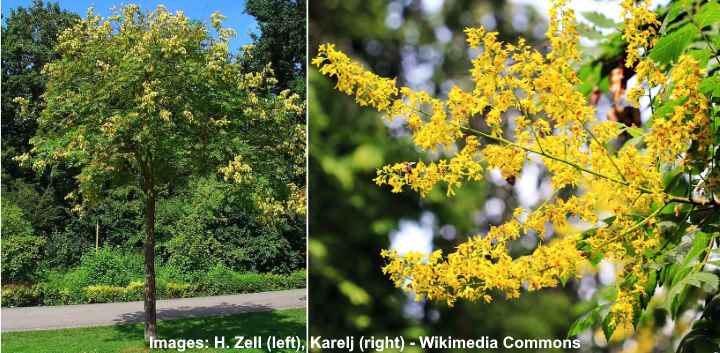
The golden rain tree is a small, ornamental tree known for its attractive, four-petaled golden-yellow flowers that appear in long clusters. The tree’s broad, rounded canopy makes it great for providing shade. The tree has alternate, feather-like leaves that emerge pinkish-purple in color. During the fall, the tree produces hanging, orange-brown, papery seed capsules, which emerge green and ripen to an attractive orange-pink hue.
For optimal growth, the golden rain tree needs moist, well-drained soil. It can also tolerate both drought and salt spray once established. Its stunning blooms make it a popular choice for being a focal point in any outdoor setting and a great source of shade with its wide-spreading branches.
The golden rain tree can grow 30 to 40 ft. (9 to 12 m) tall. It grows in USDA zones 5 to 9 in full sun.
Ylang Ylang Tree (Cananga odorata)
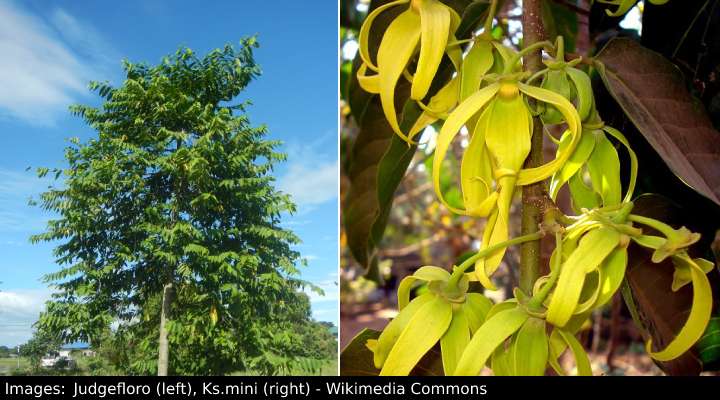
The ylang-ylang tree is a rapidly-growing tropical tree with drooping branches covered with glossy, dark-green leaves. It is known for its pendulous clusters of ornamental yellow flowers. The tree is often used for its essential oil, extracted from its aromatic flowers, which is commonly used in various perfumes. Additionally, the tree produces clusters of oval-shaped black fruits, which serve as an important food source for birds.
Ylang-ylang trees grow best in neutral, well-draining soil and thrive in humid, tropical climates. These trees are often used for shade due to their lush canopy and spreading branches. They also make great focal points or specimen trees in medium to large-sized gardens and landscapes due to their striking, fragrant flowers.
The ylang-ylang tree can grow 30 to 70 ft. (9 to 21 m) tall in USDA zones 10 to 12. Plant this tree in full sun.
Yellow Poinciana (Peltophorum pterocarpum)
The yellow poinciana is a deciduous, yellow-flowering tree commonly found in Florida. Also known as the yellow-flame tree, this beautiful, tropical tree can be identified by its showy yellow flowers that grow in clusters on upright stalks. The tree’s brilliant yellow blossoms cover its canopy with a golden blanket from spring through fall.
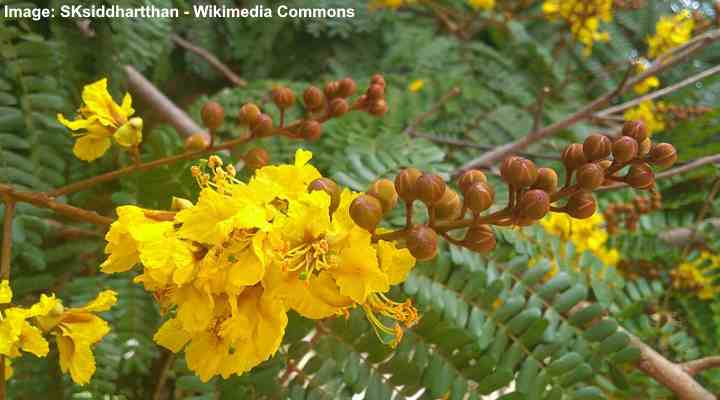
Yellow poinciana flowers
The yellow poinciana’s feathery, bipinnate leaves, attractive yellow flowers, and red-black seed pods make it a visually appealing ornamental tree all year round. In addition, the tree’s fragrant flowers attract pollinators such as bees and butterflies. Make sure not to mistake this tree for the jacaranda tree, which has similar foliage but purple flowers.
The yellow poinciana can be grown in USDA zones 10 and 11 in full sun. In Florida, it can be grown south of West Palm Beach and Fort Myers. This tree can grow 30 to 50 ft. (10 – 15 m) tall and has a wide, spreading canopy.
Weeping Bottlebrush Tree (Melaleuca viminalis)
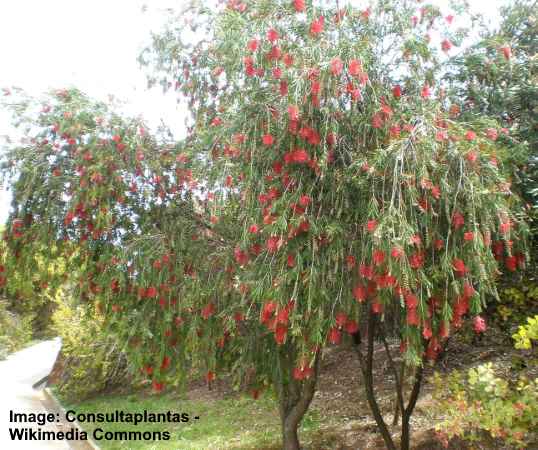
The weeping bottlebrush tree is a small flowering tree commonly grown in south Florida. The tree is known for its weeping branches and bright red flowers that resemble bottlebrushes. The beautiful red flowers contrast nicely against the long, narrow, lanceolate green leaves.
Weeping bottlebrush trees are moderately fast-growing, reaching mature heights of around 15 ft. (4.5 m) tall. They are cold hardy down to 20oF (-6°C). Grow in full sun, well-draining soil in USDA zones 9 to 11. Make sure to keep this tree away from salt spray and frost.
Pongam Tree (Pongamia pinnata)
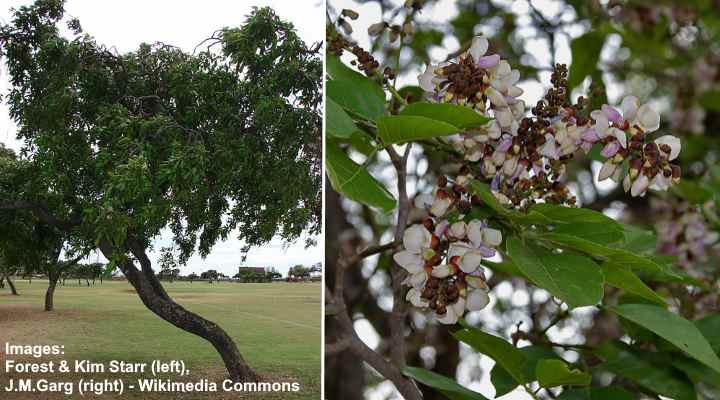
The pongam tree is a fast-growing, tropical tree with pinnately compound, glossy green leaves that are 3 inches (7.5 cm) long. It is known for its creamy white or lavender pea-like flowers that bloom in spring. The tree has a wide, spreading canopy, making it suitable as a shade tree in warm climates.
It is important to note that the pongam tree produces poisonous seed pods that grow in drooping clusters, so avoid planting the tree in places where children or pets may be around.
The pongam tree can grow 35 to 40 ft. (10 – 12 m) tall and wide. It is suitable for growing in USDA zones 10 to 11 in full sun or part shade. The tree is tolerant of many different soil types but grows best in well-drained soil.
Gumbo-Limbo (Bursera simaruba)
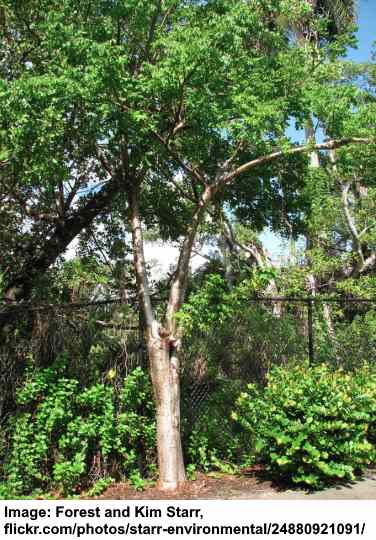
The gumbo-limbo is a beautiful, tropical tree native to south Florida. Its wide, spreading crown makes it an excellent shade tree. In late winter or mid-spring, the tree produces tiny greenish-white flowers that grow in spiky clusters. In addition, it is also recognized for its smooth peeling red bark, alternate, pinnately compound leaves, and attractive diamond-shaped red berries.
The gumbo-limbo is sometimes referred to as the turpentine tree because of the fragrance the crushed leaves emit. Its ability to withstand strong winds is particularly remarkable, making it a fitting choice for areas prone to hurricanes, such as southern Florida. The tree is fast-growing and low-maintenance once established.
The gumbo-limbo grows up to 25 to 40 ft. (7.5 – 12 m) tall. It is suitable for USDA zones 10 and 11 in full or partial sun.
Anacua (Ehretia anacua)
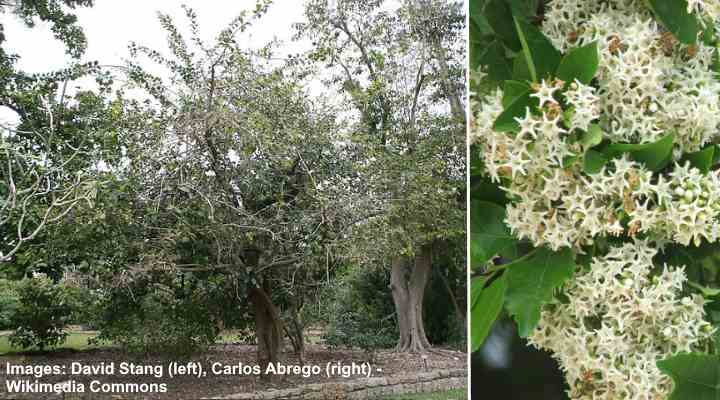
The anacua is a medium-sized, semi-evergreen, or evergreen tree native to south Texas. This spring-blooming evergreen tree grows abundant clusters of small, fragrant white flowers. Other identifying features include yellowish-orange, spherical fruits, and dark green, leathery leaves. This multi-stemmed tree also showcases flaking, thick brownish bark that becomes furrowed as the tree grows older.
The anacua tree blooms in spring, making the big tree look like it’s covered in a blanket of snow. Due to its medium size and wide-spreading canopy, it serves as an excellent choice for providing shade in parks or expansive gardens.
The anacua tree is also known as the sandpaper tree or knockaway tree. The tree thrives in full sun and heat, growing up to 20 to 40 ft. (6 – 14 m) tall and up to 45 ft. (13.7 m) wide.
White Fringe Tree (Chionanthus virginicus)
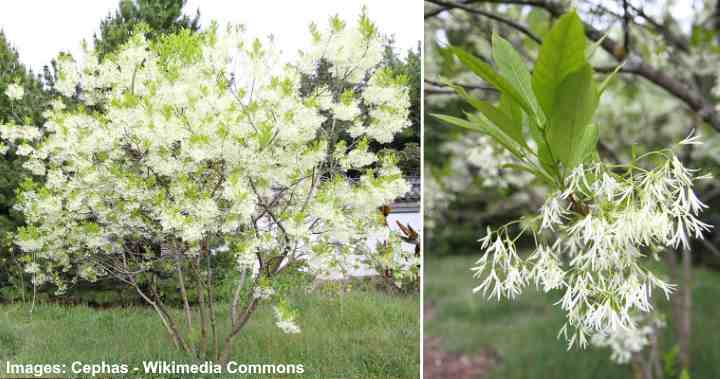
The white fringe tree is a small-sized, deciduous tree native to the eastern United States. This spring-blooming tree is characterized by its mildly-fragrant, creamy-white flowers. The flowers have delicate, spider-like petals, giving the tree a distinctive appearance. It also has lance or oval-shaped leaves that turn striking shades of yellow in autumn. Clusters of dark blue, egg-shaped fruits will appear on the tree during the summer, as well as a blanket of white petals at the tree’s base.
The white fringe tree grows in full sun or partial shade. Although it is recommended that the tree receives at least six hours of sunlight per day for the most abundant flowering and growth. In addition, it is adaptable to many soil types, but it is best to plant in well-drained, moist soil.
You can cultivate the white fringe tree in mixed borders, as striking individual plants, or in clusters to create a captivating display of flowers. White fringe trees enhance the appeal of any landscape with their beautiful white blossoms and appealing foliage.
White fringe trees can reach 12 to 20 ft. (3.6 – 6 m) tall and wide. The tree grows in USDA zones 3 to 9.
Two-Wing Silver Bell (Halesia diptera)
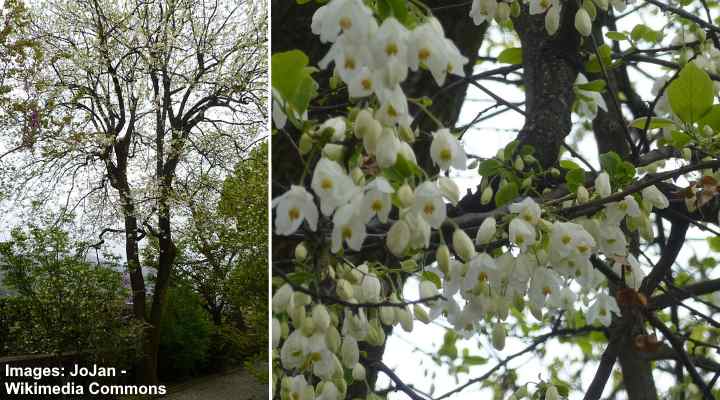
The two-wing silver bell is a stunning deciduous tree native to the southeastern United States. This small decorative tree is known for its clusters of bell-shaped white flowers that bloom in spring. The fragrant flowers are especially attractive to bees and hummingbirds, making this tree perfect for wildlife gardens. It has oval-shaped, deep-green leaves that turn a beautiful shade of yellow in autumn before dropping.
For optimal growth, plant the two-wing silver bell in full sun and acidic, organically-rich well-drained soil. This compact ornamental tree is well-suited for cultivation as an individual focal point, a specimen tree, or as part of a shrub border.
The two-wing silver bell can reach a mature height of 20 to 30 ft. (6 – 9 m). It is suitable for growing in USDA zones 5 to 8 in full sun.
Desert Willow (Chilopsis linearis)
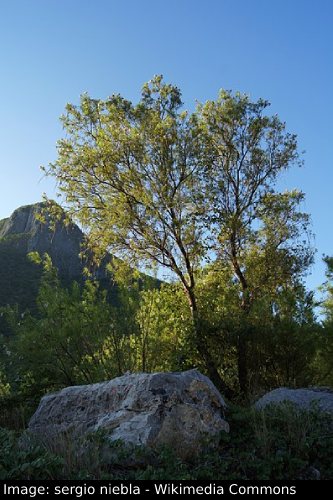
The desert willow is a small, pink-flowering tree with willow-like, narrow leaves that are pale-green in color. The tree is known for its exquisite pink-violet trumpet-shaped flowers. Other identifying features of this tree are its distinctive, twisted branches, and rough, exfoliating bark. This deciduous tree also features an attractive silhouette, which adds to its visual appeal in the winter months.
The desert willow produces narrow, bean-like seed pods that contain flat, winged seeds. The seeds are eaten by birds and the flowers are pollinated by hummingbirds and bees, making the tree a perfect choice for wildlife gardens. In addition, the tree is also fast-growing, low-maintenance, and drought-tolerant.
Native to the southwestern United States, the desert willow grows in full sun and well-draining soil. It is well adapted to arid, desert-like conditions. Make sure to properly fertilize the soil when the tree is being established. It grows 15 to 30 ft. (4 – 6 m) tall and 10 to 20 ft. (3 – 6 m) wide. Grow in USDA zones 8 to 11.
Related articles:

